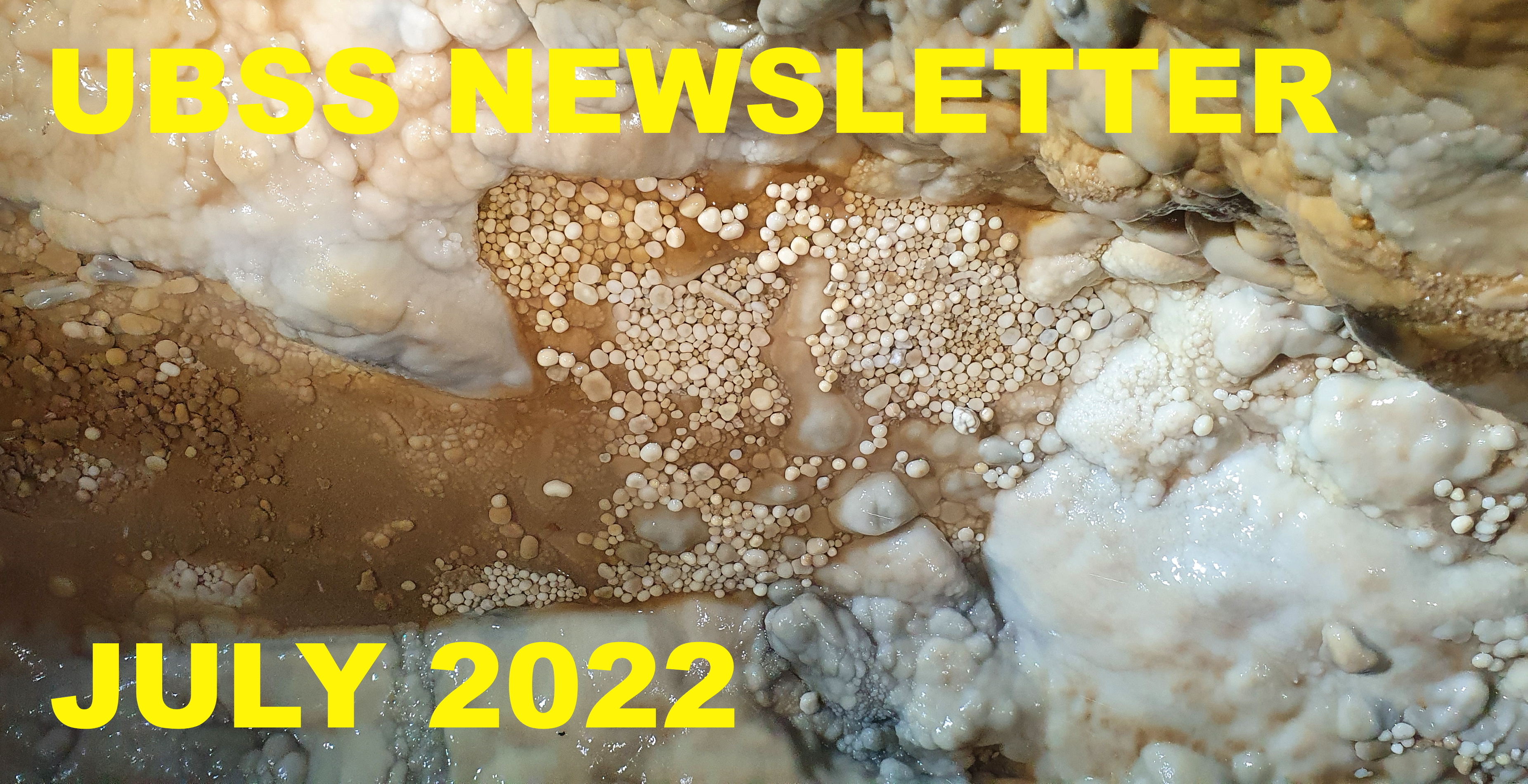
Cave pearls in Masson Mine, Derbyshire. Photo by Linda Wilson
|
|
There's
no better escape from the unusually hot British summer than clambering
into a nice cool cave! We've got plenty of caving articles for you this
issue, and more to come when everyone gets back from their summer trips.
One group has been in France at the International Congress, helped by
grants from the Tratman Fund, the Oliver Lloyd Memorial Fund and the
British Caving Association. Rumours of mass 2am skinny dipping in a
nearby lake are naturally wholly unfounded (oh cavers, never change!).
And by the time the next newsletter appears, another group will be in Co
Clare, with Ash cracking the re-surveying whip as ever. The Tratman
Fund and the Lloyd Fund are also assisting with funding for that trip.
We'll await tales of everyone's summer caving exploits and don't forget
that you can use Zac's natty little trip reporting form if you haven't
got the energy for anything too long!
Tell us where you've been!
Have a great summer, folks, and see you again in a month's time!
You can find all the back issues of the monthly newsletter online.
Linda and Zac (who hasn't actually seen this as he's still in France)
|
|
CARD READER IN STORES
There's now no excuse for not
paying your tackle fees, hut fees or anything else you owe, as there is
now a card reader in the Tackle Store in the Richmond Building. However,
it's important to remember to turn it off after use, as Tackle Warden
Henry Morgan explains...
The
card reader needs to be turned off when you leave it (or just
re-started when you want to use it, if it wasn't turned off). The reader
seems to have trouble finding a signal if it's left on its own for a
while. Note that is does NOT need WiFi, even though it will try to
connect to a network. Simply ignore that and it will find signal when
you turn it on.
Henry 'the Tackle' Morgan
|
|
WHEN I'M IN WIGMORE THERE'S NO PLACE I'D RATHER BE ...
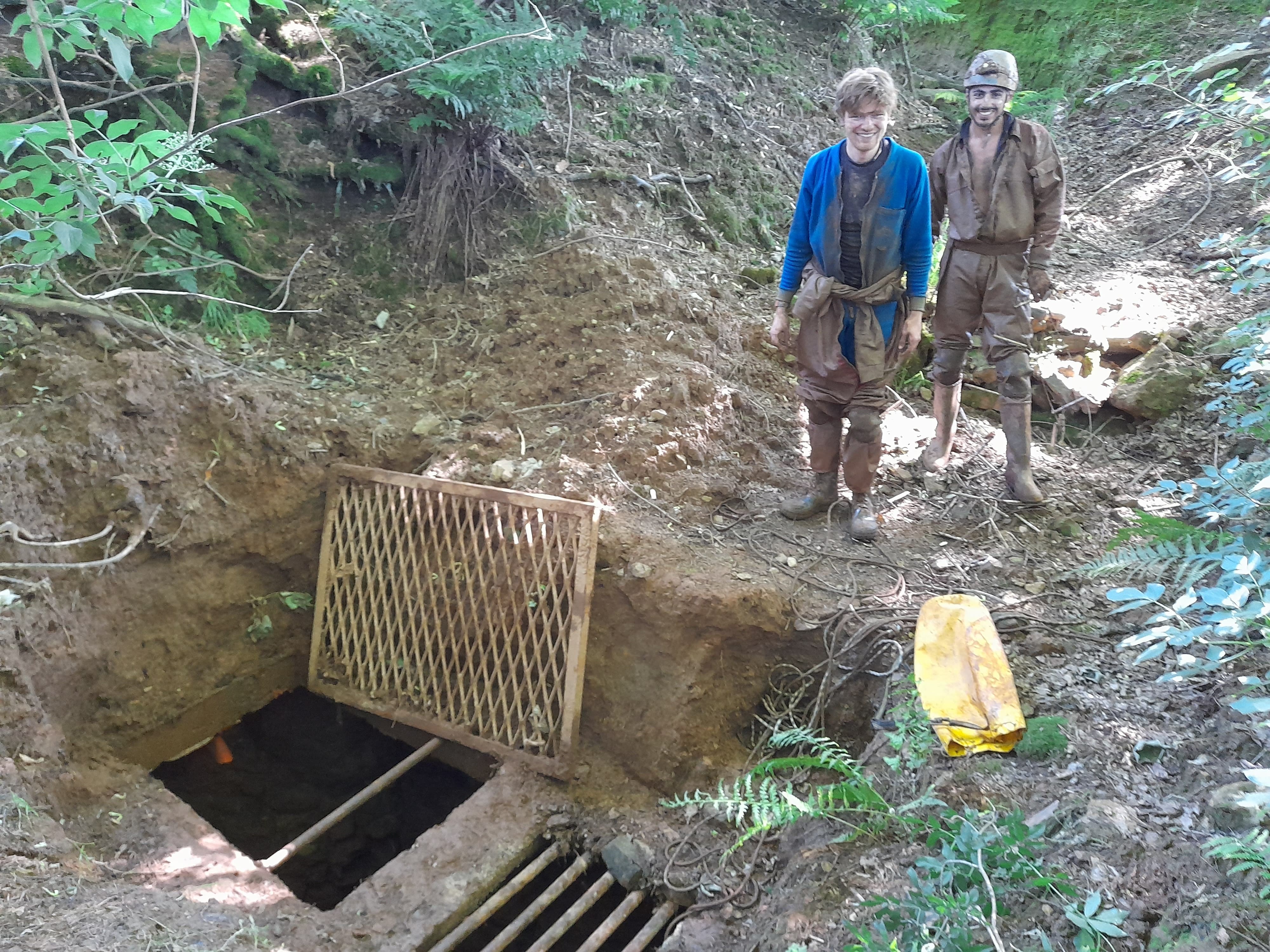
Ben Wynn and Nicholas Stylianou at the entrance to Wigmore Swallet. Photo by Henry Morgan.
Have you ever wondered about the
truth behind some of the more grandiose guidebook descriptions?
Well, wonder no more, and welcome to our new ‘Tell it how it is’
feature, in which we attempt to shine a light into some of the darkest
places underground, while you remain warm and dry in the pub/your
armchair/the bath at the hut. First up is Wigmore Swallet, with Henry
Morgan providing a candid view of this little-known delight.
I recently took a trip to Wigmore Swallet, on eastern Mendip, with Ben
Wynn and Nicholas Stylianou. After having done most of the ‘big trips’
on Mendip, I had found myself scouring Mendip Underground for ideas for
my next trip, and I wanted to start exploring some of the less well
visited caves. Wigmore seemed like a good place to start. The promise of
an ‘impressive’ streamway, and ‘the long term potential to become one of the longest and deepest caves in England’ were key lines that whetted my appetite to see what this little mentioned hole might have to offer.
Mendip Underground does not give the upper series much space; it seems
that most of the description of this cave is reserved for the sumped
passages passable only by divers. There is, after all, less than 50m of
the streamway accessible before diving is required. However, after
completing this trip, we felt that the description could do with some
more detail, and perhaps a little more honesty when describing ‘roomy’ and ‘impressive’ features. Below, I shall offer our experience of each section, alongside the MU version given in red:
WARNING: The initial passages are liable to spoil run-ins and may require re-excavation.
The 10m entrance shaft (10m ladder and 25m
lifeline) leads via a short crawl into Hesitation Chamber, at the far
end of which are two consecutive 3m free climbs. From the base of the
second, the 25m Christmas Crawl enters Santa’s Grotto, a spoil filled 6m
diameter chamber with a small grotto on the right hand side.
We located the entrance without difficulty, and the farmer kindly let us
park our cars on the farm track, so we had only a two-minute walk to
the entrance. Thankfully there was no re-excavation required, though the
entrance grill (see photo) was rather heavy and precariously balanced
over the very exposed shaft. Some tentative faffing ensued to remove the
grille and Ben set up our first ladder and lifeline while avoiding a
premature descent by stepping carefully around the shaft.
Side note 1: I don’t know
why, and I suspect that it is another symptom of ‘Mendip Syndrome’ (see
below), but there does seem to be a belief among some cavers that using a
ladder and lifeline is less faff than SRT.
The amount of tackle required is immense, a ladder for starters, a rope
twice the length of the pitch, a hundred slings, and more crabs than for
SRT.
This is before we begin with the faff of belaying down a ladder, and the
tangle you always end up in with the ladder and your lifeline.
‘Bring back, bring back, oh bring back my ladders to me, to me’ – What utter bollocks.
Bring back my SRT kit to me!
We descended the pitch (more like 7m with a small climb at the bottom)
and started crawling. On the way in we missed the grotto, but this
section of cave provided no real surprises.
To the left a scramble down over spoil bags
reaches Pinks and Posies, a crawl dropping into the low Blitz Passage
which after 10m enlarges at a 2m climb down into a tiny chamber,
Baghdad. Beyond is the awkward Sheep Dig, the start of more crawls and
short drops which thankfully emerge after 15m at the head of the roomy
Blackbird Pot.
Blackbird Pot is an easy 6m free climb (in dry weather!), and is
followed by a roomy rift which quickly leads to the 12m deep Vindication
Pot (15m ladder and 35m lifeline). This is usually bypassed by an
awkward rift climb immediately before the shaft (20m handline required).
Ahh yes, Mendip syndrome. To those unfamiliar with this disorder, it
seems to affect cavers from the south of England most severely, symptoms
include (but are not limited to):
- A
need to dig further in tiny, tiny holes, simply because one ‘could’,
without stopping to think for even a second as to whether one really
‘should’ continue to push a lead.
- The
need to describe and name every single metre of dug out passage in
excruciating detail, even if it is not worthy of such note.
- The
belief that by excavating body size tubes in the ground they are
somehow contributing to the greater good of the caving community by
opening up new trips, when in reality they are simply increasing
Warmbac’s revenue by virtue of extra kneepad and tackle sack sales.
- A
need to grossly exaggerate the size of any small passage as a ‘chamber’
when one can fully extend even a single limb, let alone actually stand
up.
A more realistic description here would be ‘Follow the crawl until you reach Blackbird Pot’.
This, incidentally, is not a ‘pot’, but merely a slight verticalization
of a small passage. It is not a pot, or a pitch, or anything remarkable
at all in fact and should not be described as such.
Side note 2: A ‘pot’ or
‘pitch’ is a name that should be reserved for a piece of cave requiring
some form of technical ability to pass. This can, in exceptional cases,
be just a handline though really a ladder, or better a rope and SRT kit,
should be required for a pot or pitch to really deserve this status.
Having established that Blackbird Pot was neither a pot, nor roomy, we
continued down the ‘roomy’ rift (also not roomy) to ‘Vindication Pot’
(actually a pot).
I can see how a severe case Mendip Syndrome could lead to one feeling vindicated at finally
breaking through into real cave after the long hard preceding slog.
However, I feel this term needs a little scrutiny. Let us examine the
dictionary definition of the word ‘Vindicated’.
“Vindicated: shown or proven to be right, reasonable, or justified.”
Therefore, to be ‘vindicated’ for the hours, days, weeks, months and
years spent excavating a tiny scrotty hole in the corner of a farmer’s
insignificant field south of Bristol, one really needs the ends to
‘justify’ the means. One should feel that they have been ‘proven right’
to have committed such time and effort to the cause.
What is found hereafter, I regret to conclude, does not fulfil that description.
From the floor of Vindication Pot a further
climb down through shored up boulders, Hernia Pot, reaches a tight,
vertical 2.5m rift and 30m of narrow passage. This passage is
interrupted halfway by the blind, ‘tackle eating’ and 5m deep ‘Piss
Pot’, before reaching Butch’s Arse, a small U-tube in the floor. Through
this leads to 6m of blaster narrow passage, at the far end of which a
traverse line (Cow’s tails recommended) is in place to assist on the
awkward and exposed move out over the head of the 10m deep Black Pudding
Pot (10m ladder and 25m lifeline). WARNING: Extreme care is needed here. A
descending rift squeeze then leads to the 7m deep Yeo Pot (10m ladder
and 25m lifeline) and a further 6m of passage intercepts the impressive
main streamway, the Upper River Yeo.
We descended Vindication Pot by the bypass rift (awkward on the return,
fixed handline in place). There were actually two ways on at the bottom
of here (in addition to the M25, mentioned later). The right-hand hole
leads quickly to a sump and the left to Hernia Pot (also definitely not a
pot). The first 15m of tight passage to Piss Pot (just about a pot)
presented us no real troubles but would be awkward for the larger caver.
The passage turns 90 degrees to the left at Piss Pot we found Butch’s
Arse. This U-tube had lots of silted up mud and general mank in it,
making me think no one had been down here in quite some time! There is
just about room to turn around in here if one is determined enough.
We passed an old can of WD-40 and wallowed in some thixotropic mud
before entering the blasted passage. This was an exceedingly awkward
passage when towing a tackle sack containing two ladders and associated
lifelines, with an even more difficult manoeuvre to reach the bolt to
rig the ladder from. I went headfirst, a big mistake! (Best to reverse
to Butch’s Arse and turn around, to employ a feet first approach, facing
the right-hand wall as you go into the cave). I had to reverse and
awkwardly turn around, then going feet first towards the open blackness
ahead. I was very thankful for my cow’s tails and the traverse line
here, as I had to throw myself over the edge of the black open pit with
no view of any footholds, hoping that my ability to wedge my shoulders
into the preceding rift would stop me plummeting downwards! I eventually
managed to get upright on a small foothold at the top of the pot to rig
the ladder. Here there was an in-situ carabiner with a good 1 cm thick
coating of calcite – very impressive!
Side note 3: The reverse of
this manoeuvre – entering the very tight vertical rift 1m above you
with a heavy tackle sack – on the way out is perhaps the most awkward
move I have ever done underground. It requires a lot of strength and
flexibility, and it is probably best to have someone go all the way back
to Butch’s Arse, turn around, come back headfirst though the rift and
pull the tackle sack into the rift before you then follow it in. We did
not do this, as Ben was too long to turn around in Butch’s Arse, but
this did result in an exceedingly awkward time at the pitch head!
(Really do take your cowstails for this bit!!).
At the base of Black Pudding Pot, Ben went first through the ‘descending
rift squeeze’ which has a fixed handline (useful on the return) and was
very awkward for all. Thankfully Yeo Pot has an easier take off
(rigging off a somewhat dubious sling placement around a large natural),
and at this point the sound of the streamway below was ushering us on
to the bottom!
Detour along the M25
Back at the head of Hernia Pot, a muddy
tube, the M25, reaches a slippery 10m free climb (care needed) up into
Don’t Feed the Ambulance. This is a roomy chamber in a washed out
mineral vein with a blind 10m aven above and a desperate traverse across
to the head of Vindication Pot. WARNING: This is very loose and should be avoided. At
the top of the chamber a filthy 3m climb (fixed handline) followed by a
short crawl and 5m climb down gains access to the sizeable Drake’s Hall
where a dangerously unstable excavated aven terminates in a suicidal
boulder choke 16m above (avoid!).
Well, we decided to take the M25 on the way into the cave, thinking we
probably wouldn’t be bothered on the way out (correct!). A short muddy
tube led to the excellently named Don’t Feed the Ambulance, though it
feels more like just walking through a moderate chamber than a slippery
10m free climb. We didn’t fancy the look of the desperate traverse back
to Vindication but me and Ben did do the filthy climb up and then I went
down into Drakes Hall (very muddy!).
This is a reasonably sized chamber but with nothing of particular note
in it (I didn’t go looking for the boulder choked aven!). At this point I
turned around and headed back to join the others who waited in Don’t
Feed the Ambulance. We then continued down Hernia ‘Pot’.
The accessible active streamway, the Upper
River Yeo, is a roomy passage over 90m long. It is sumped at both ends
and evidence of foam above downstream sump 1 indicated that this passage
is often flooded. Moving upstream for 47m Sump 1 is reached, where a
shallow 2.5m free-dive leads to a 3m diameter airbell. Beyond is the 5m
Sump 2 which reaches a depth of 2m and has been free-dived, although
visitors may encounter nil-visibility and should be aware of the
presence of roof pendants. WARNING: There is no free-diving line through these sumps.
Expecting great things, we eagerly entered the streamway. After all that
crawling and awkwardness, with the promise of an ‘impressive’ and
‘roomy’ streamway, we were mildly disappointed to say the least. OFD it
is not.
A clear case of Mendip Syndrome at its finest, we were actually able to
stand up for about 5m before the normal service of stooping and then
hands and knees crawling resumed as Nick led us up the ‘roomy’
streamway. Nick found upstream sump 1 and cheerfully reported that it
only resembled a duck today. Needless to say, neither Ben nor myself
were in the slightest bit interested at this point! Feeling miss sold,
we trudged to a bank where we could actually sit up and had a gourmet
feast of fruit pastils, soggy Henry Hippos and a Mars bar.
From the bottom of the cave, we made an exit, it was not swift or
enjoyable, but it was an exit. Ben cheered us up with a variation on
Jess Glynne’s ‘When I am with you there’s no place I’d rather be’ though
that was surprisingly pretty much as far as we got with singing on this
trip. We eventually got to the entrance pitch where between Ben and me,
we couldn’t manage to get the entrance grill back off (tired arms
trying to push a very heavy grill, whilst suspended at the top of an
electron ladder!). We got to within 30 minutes of call out, seriously
wondering how to explain to the rescue that we had managed the difficult
cave but couldn’t even open the entrance when we got back to it!
Thankfully I eventually managed to open a small crack that I could
squeeze through, before employing an end of rope to haul open the rest
of the lid.
I went back to the car in glorious sunshine to cancel call out, before
returning to help the others who were just finishing packing up the
tackle. We walked back to the car, at which point we realised that we
hadn’t taken the second tackle sack up the entrance pitch with us…
Summary: No offence intended to the original digging team, and thanks to
Ben and Nick for making the trip a good day out! However, this cave is
neither impressive, roomy, or worthwhile. Perhaps if you enjoy cave
diving that is not the case, and with the dig in Home Close Hole now
connected to the far end of the sumps, perhaps there is a classic
divers’ through trip to be had. Not for me, though.
Henry Morgan
|
|
WHITE RIVERS AND PEARLY GATES
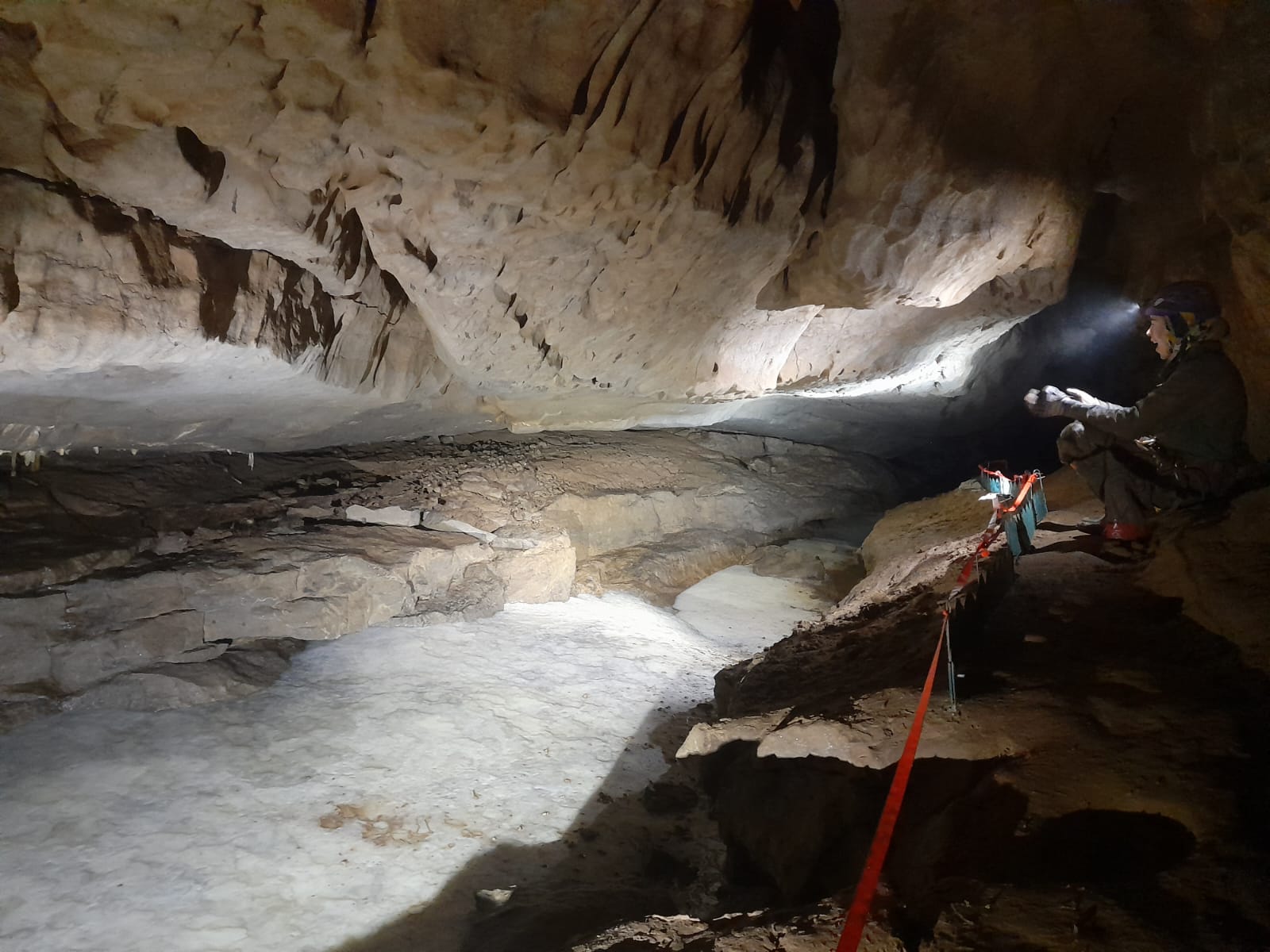
Definitely pretty!
Titan has become a popular UBSS
destination since lockdowns eased. As Merryn takes up the tale of the
latest UBSS exploits in Derbyshire, please forgive any wrongly captioned
photos as this was put together while Merryn was in France.
Henry and I visited the Peak District intending to complete a much-hyped
White River trip (see Elliott’s previous report). Having failed to find
anyone to do the Titan - JH exchange we planned to complete the trip
using just the Titan entrance – a lot of big SRT! (144m shaft!).
Inspired by the previous evening’s alpine caving talk, our first stop
was for snacks in Castleton. Multiple pastries, coffee and a Pelicase
cake were purchased, to have ‘more food than we could possibly need’.
This proved to be a good call, as we still managed to get through it all
and crave more! [Editors’ note: always remember that one of the UBSS
mottos is ‘never knowingly under-catered.’]
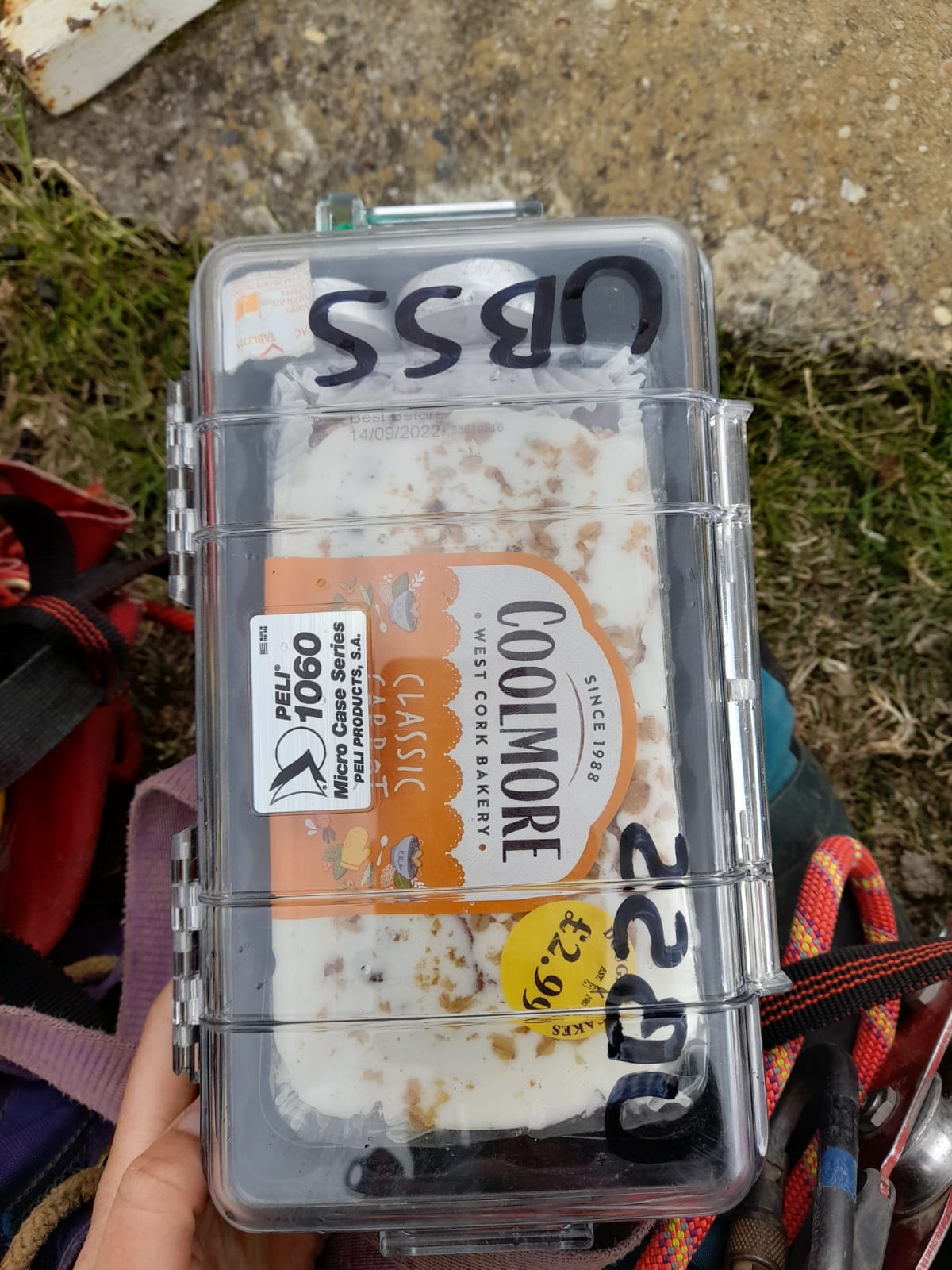
A wise investment of club funds! The case, not the cake.
After parking at the bumpy farmer’s track
and trekking across the field we arrived at the entrance, which Henry
rigged, with an intense concentration face, on fresh, slippy 8mm rope.
There is something a little unsettling about abseiling the 50m entrance
shaft on simple, whilst still in a soft lock to get enough friction!
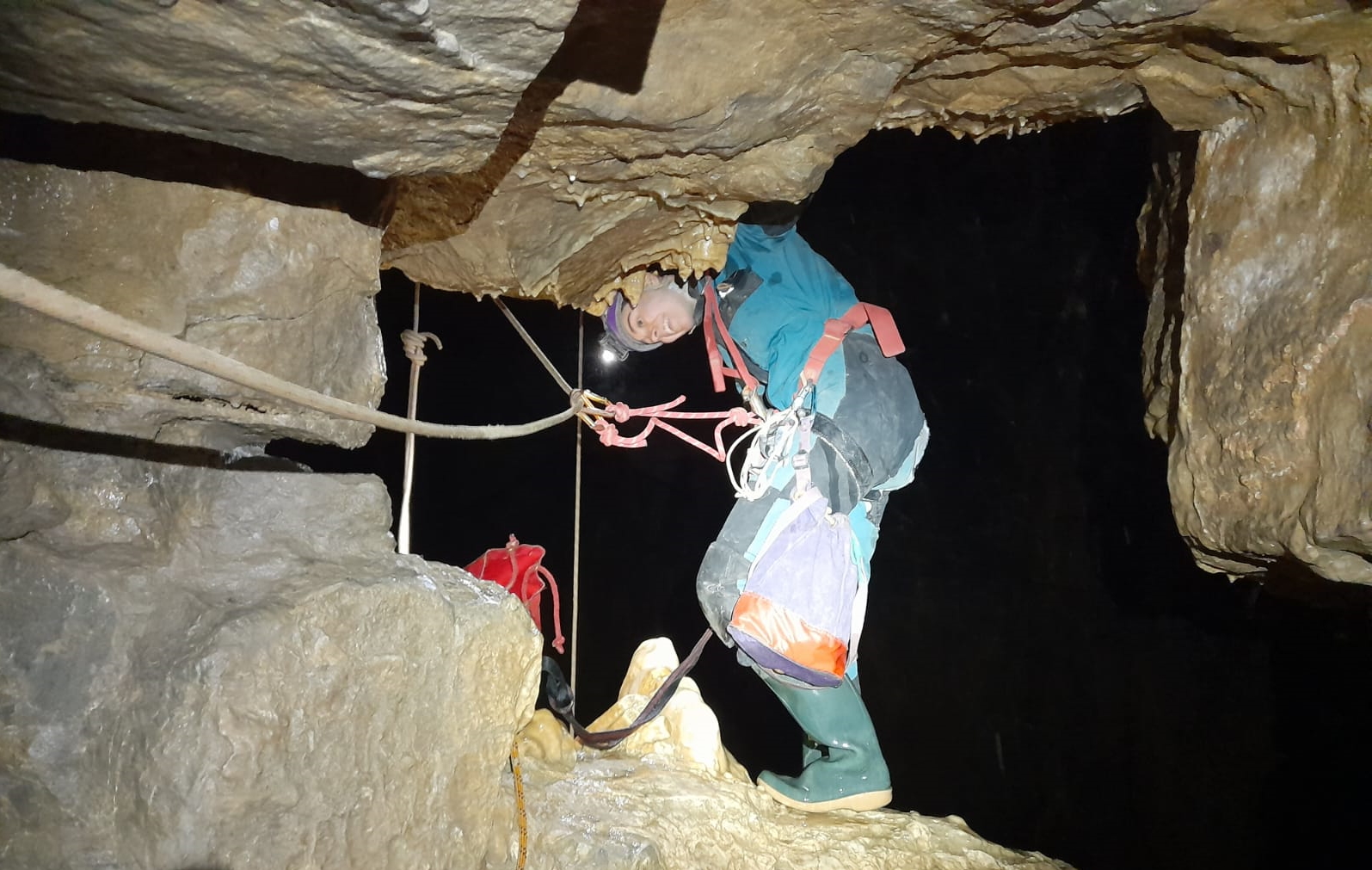
Merryn rigging.
I then rigged the top of the main shaft
pitch (70m?!), which opens out into a sound-swallowing vastness. Looking
down from the top, I could only just make out the rim of the Event
Horizon, a ledge with a free hanging re-belay before, encircling the
Blackhole 60m pitch below.
Henry boldly rigged the Event Horizon re-belay, which meant that I had
to get off and on the rope again for him to pass. This involved
entertainingly trying to weight my descender again at the bottom of 70m
rope, resulting in a ~1.5m bounce despite my best efforts to get it
tight.
At the bottom, we enjoyed a delicious half a goat’s cheese baguette
each, before beginning the boulders, crawls and ladder to the base of
JH.
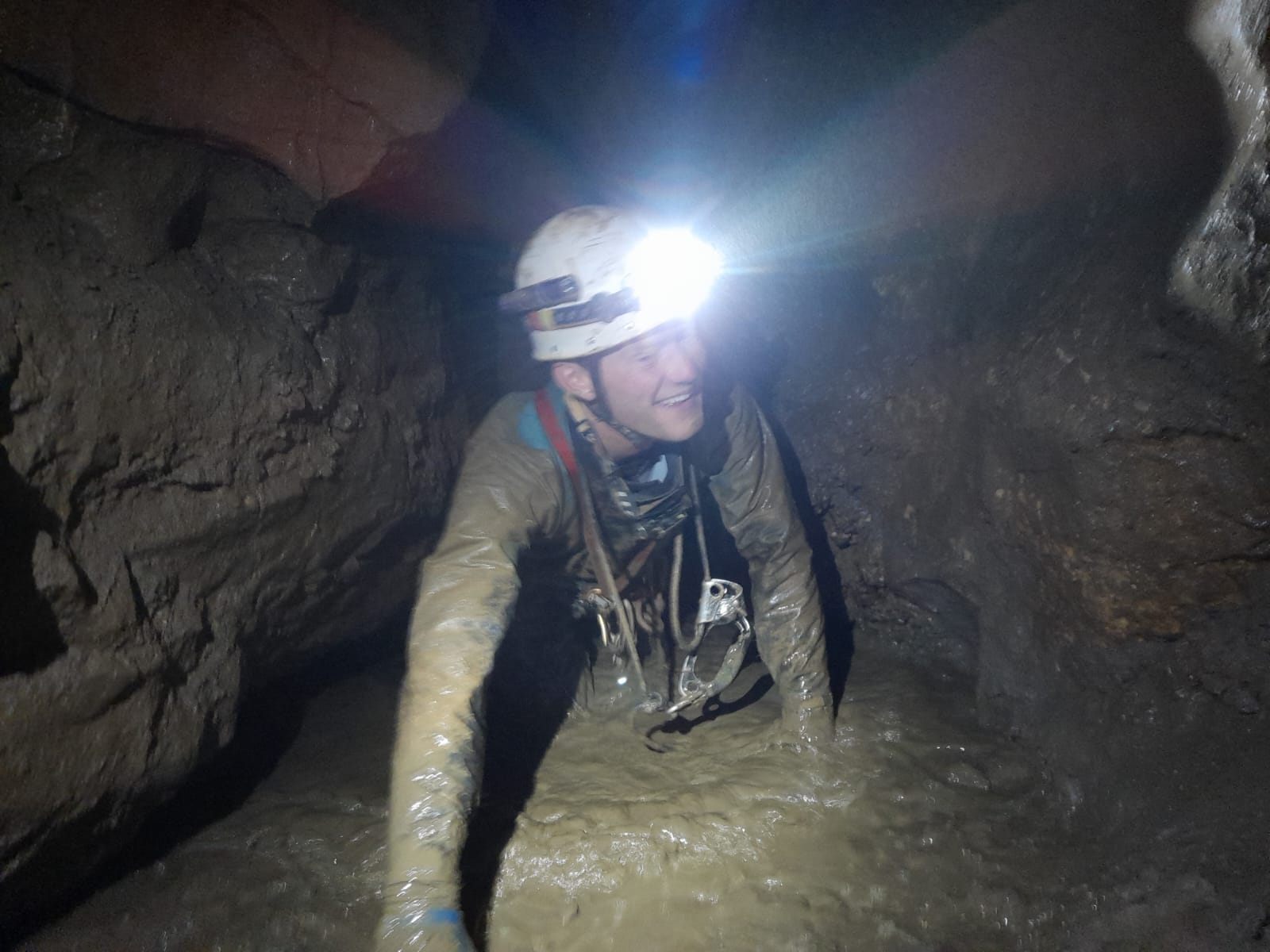
A very muddy Henry passing through Cow Arse Worms, although no worms were spotted it defo still smells.
From JH we started stonking down the
stunning streamway towards Bung Hole, getting so excited that we walked
straight past the obvious Block Hall before realising and turning back.
This series of pitches was longer than we both expected because of the
number of deviations and re-belays. The pre-rigged rope seemed fresh,
unlike a solid calcified coil hanging at the top.
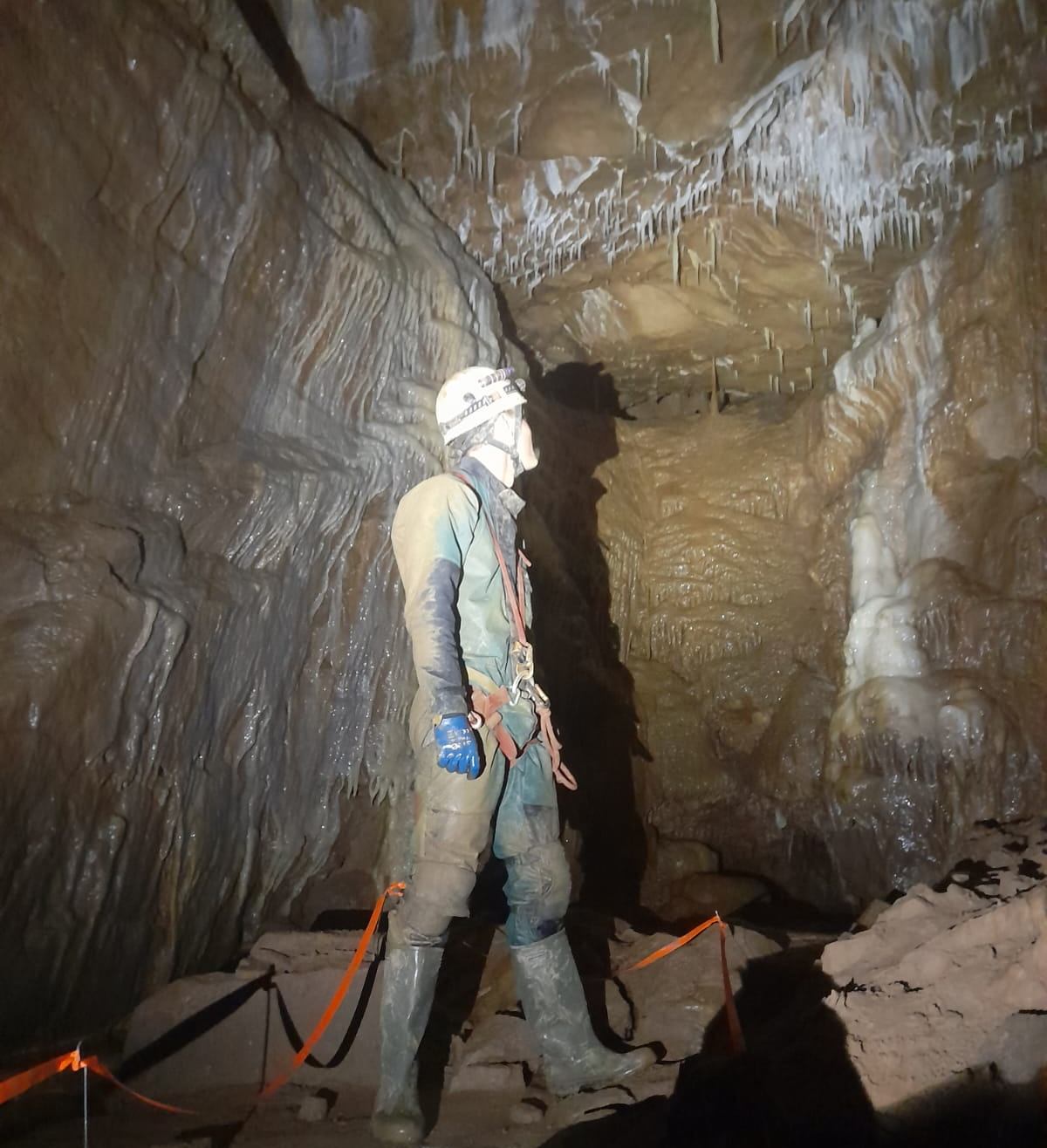
Editors' note: we're guessing this is Henry staring at the Pearly Gates.
A crawl (annoying with SRT kits on) leads
into the impressively decorated White River Passage. Conservation tape
blocks some of the oxbows/extensions, such as a section to the left
named Heaven, leaving Henry to only stare at the Pearly Gates in wonder.
Heading right leads to the White River itself, which looks impressively
like a solid white river (duh, name makes sense). We tried our best to
get photos but assure you it’s more stunning in person.
Upon reaching the descending pitches we stopped for our first crumbly
carrot cake break. There is an unrigged traverse possible over the top
of the first pitch, to more White River Passage, however we didn’t take
any rope to do it. It might also be nice to have your own rope for the
second pitch, which starts as a janky pre-rigged traverse leading to a
selection of very rusty maillons.
From here we landed in the Ventilator, aptly named because it feels like
some installed a fuckton of industrial air-conditioners in a crawl,
leading to the lovely muddy Colostomy Passage. We slipped our way along
before arriving at The Bung again, then retraced our steps back to the
Titan entrance.
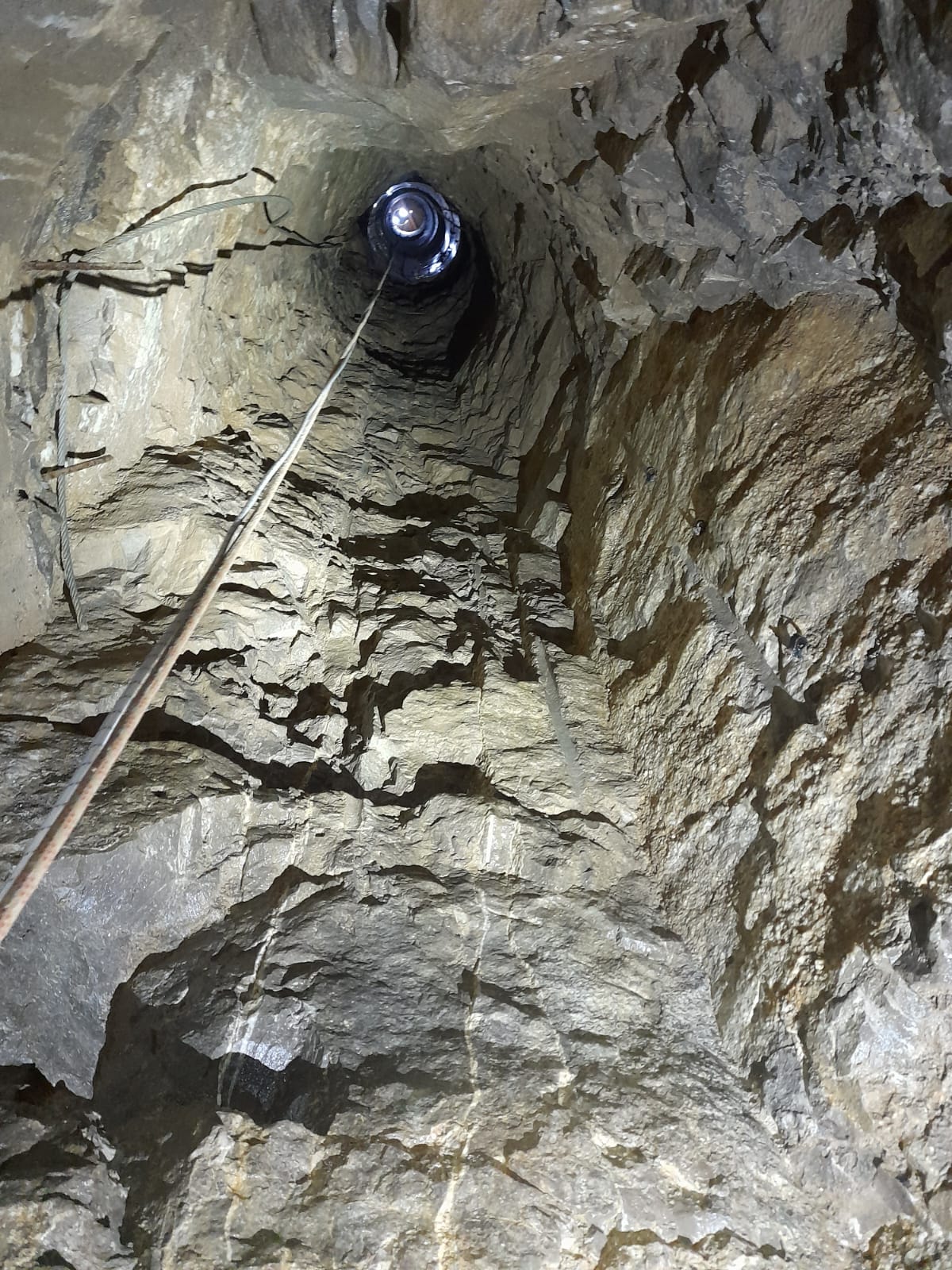
Just think of the poor sods who dug down through this lot!
Upon reaching the base of Titan, having
already done a bunch of SRT and crawls I was pretty tired. I stocked up
on the final smushings of cake and began ascending. Previously I had
gone up Titan a couple of months before with Ash but managed to avoid
any bags. I was now much more tired, unfit, and weighted. After what
seems like endless prussik squats to various tunes sung by Henry echoing
in the darkness, I reached the top of the natural pitches and entered
hysterics. This was taken out by a series of selfies and attempts to
photograph Henry though the darkness. Picture of his floating head
encapsulates how the cavern eats your light.
At the top, I faced again my nemesis - the Titan lid. It’s
annoying ‘meeah’ face judged my weak arms trying to push it open, my
heavy breathing echoing all the way down to Henry. A final huge shove
and FREE! I collapsed at the surface exhausted and ecstatic leading to
the creation of a piece of art I call ‘Surviving Titan – a Collage of
Emotion’.
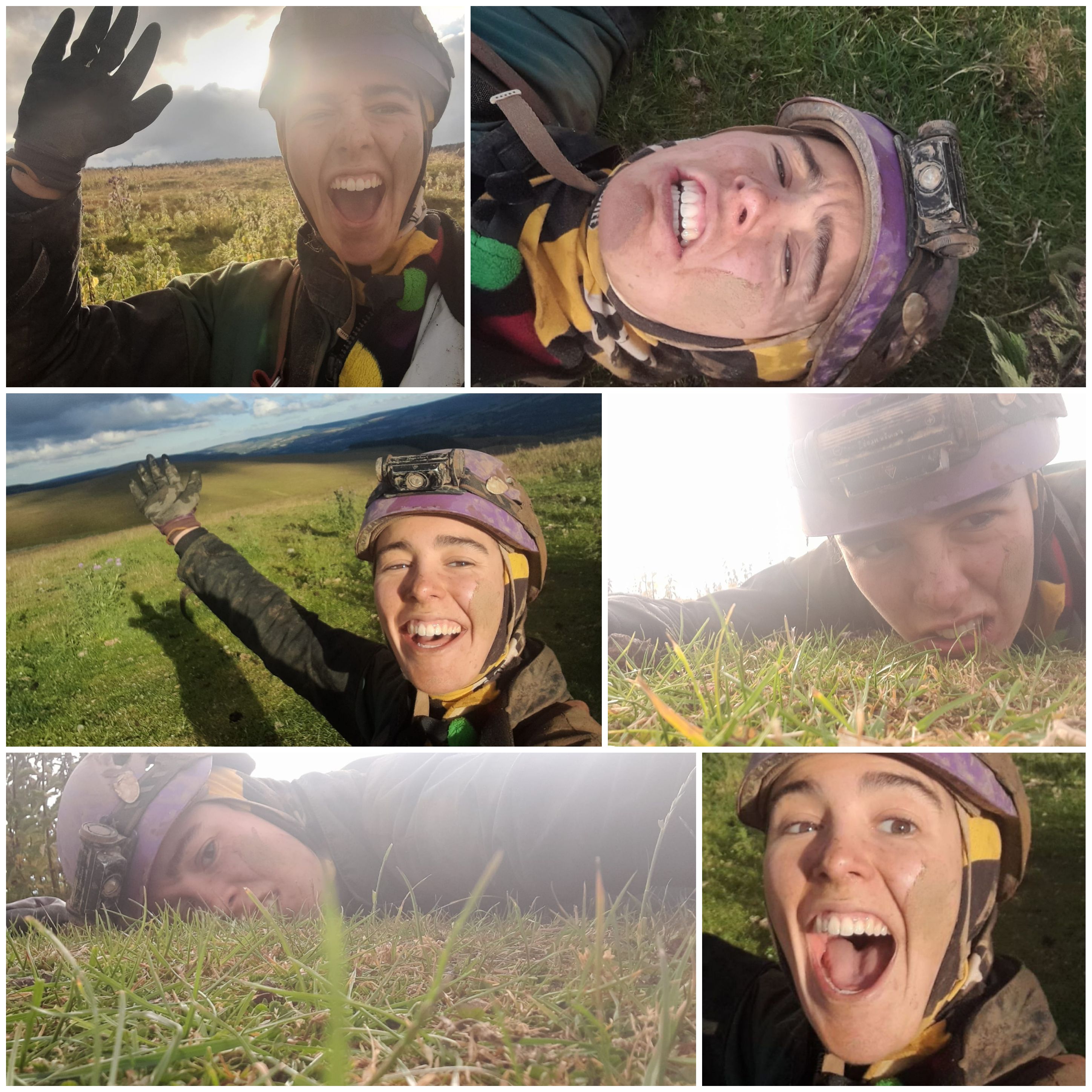
Appearing very soon in the Tate Britain next to Tracy Emin's bed and a pile of bricks.
And a picture of Henry hauling up rope.
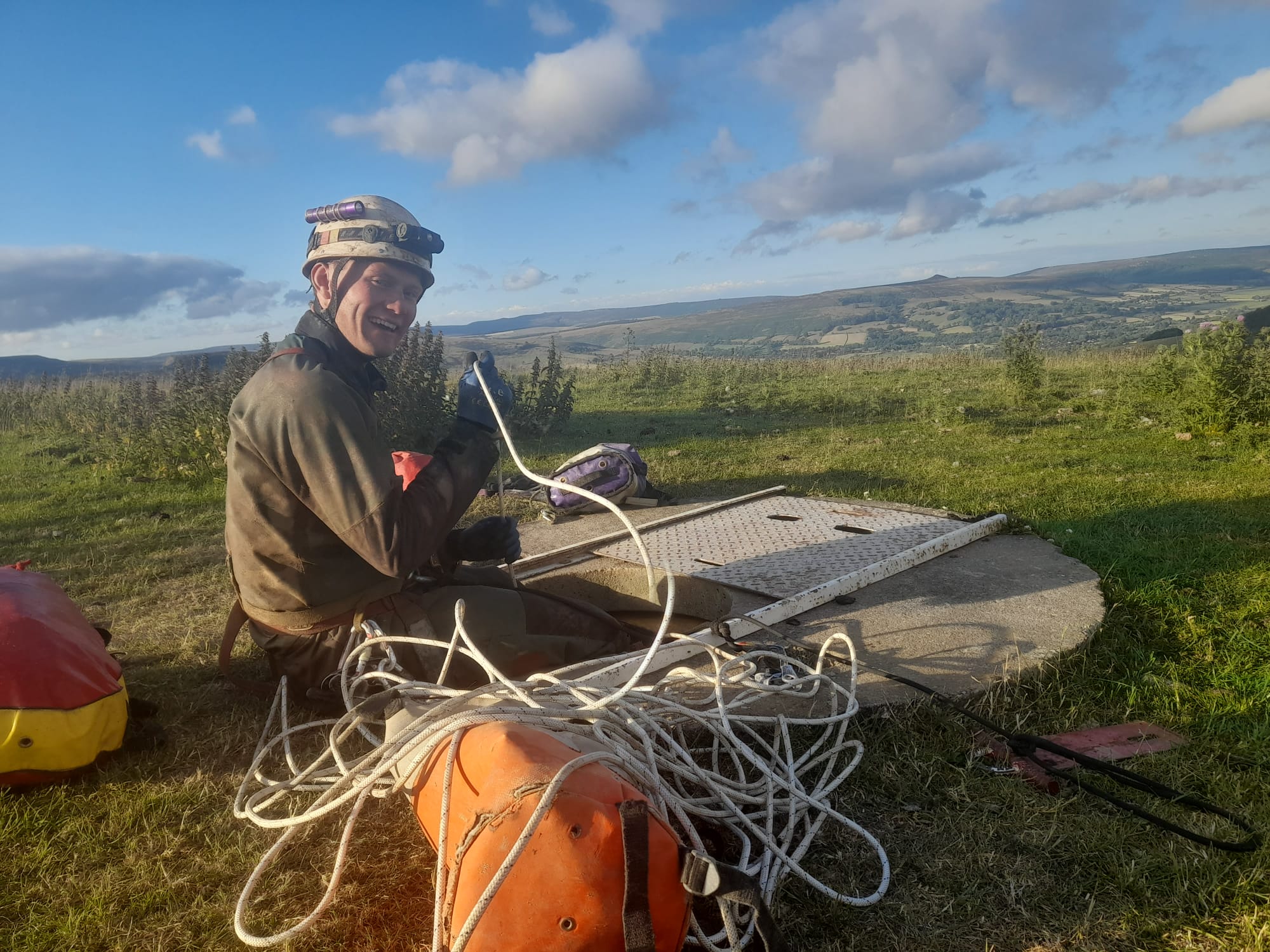
He still looks happy, despite the sad lack of cake.
Great trippp.
Merryn Matthews
|
|
MASSON MINE, PEAK DISTRICT
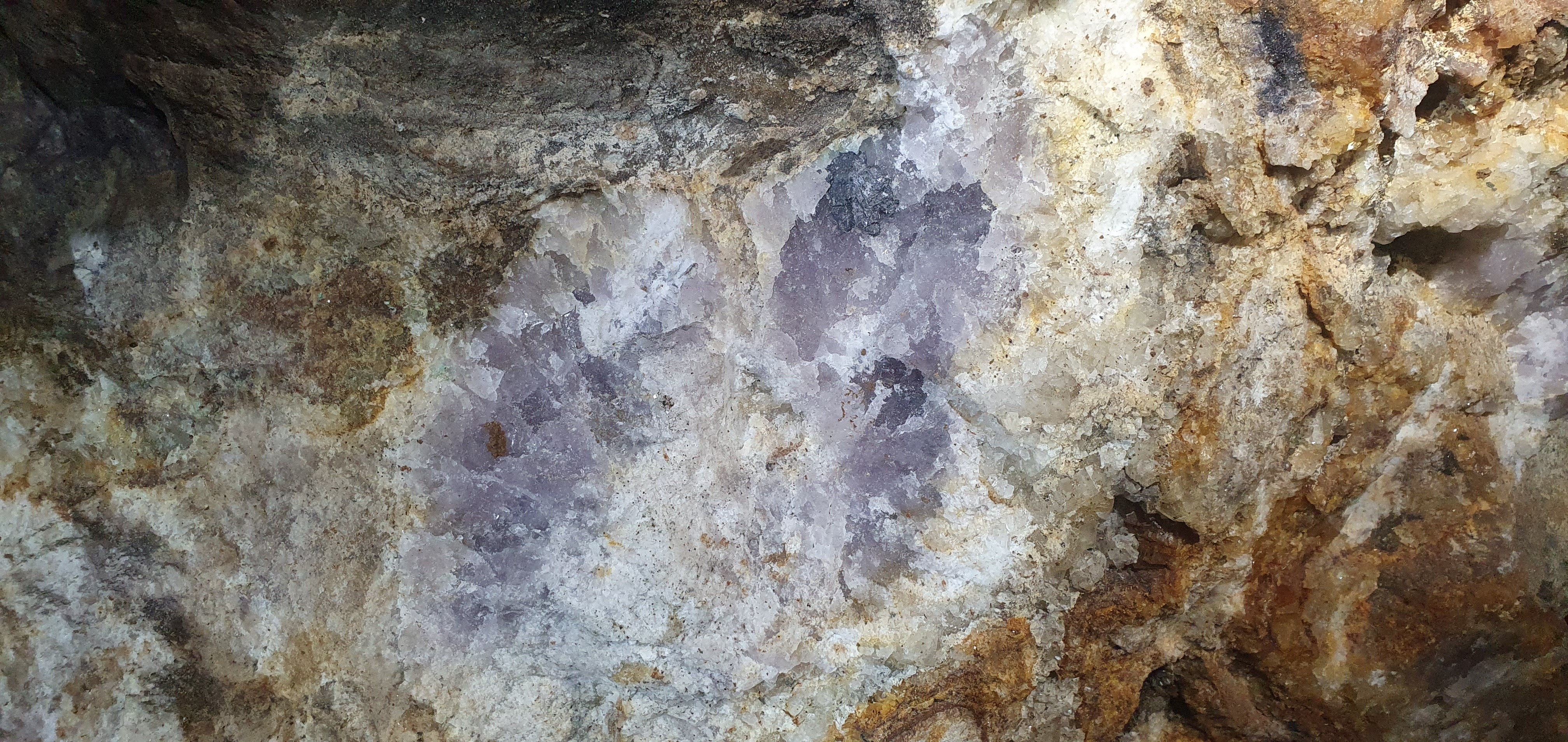
Fluorspar, Masson Mine. Photo by Linda Wilson..
When Linda Wilson ventured north for a meeting, she made a virtue out of necessity and managed a trip underground as well ...
Having recently been co-opted as a trustee of the British Cave Research
Association (BCRA), I thought I'd better turn up for the first in-person
meeting since the Plague, at the British Caving Library in Glasson
Bridge. The idea of a trustees' caving trip on the Saturday was mooted
and Jenny Potts kindly offered accommodation at the Orpheus Cottage, so
as early as I could get away on Friday 1st July, I headed north on the
M5, grossly hindered by my sat nav's burning desire to subject me to
highway robbery on the sodding M6 toll, despite my instructions to the
contrary, so faff ensued while I tried to navigate by dead reckoning and
imperfectly remembered geography while the sat nav sulked and
eventually rerouted, which took an interminable length of time and
a lot of guesswork on my part.
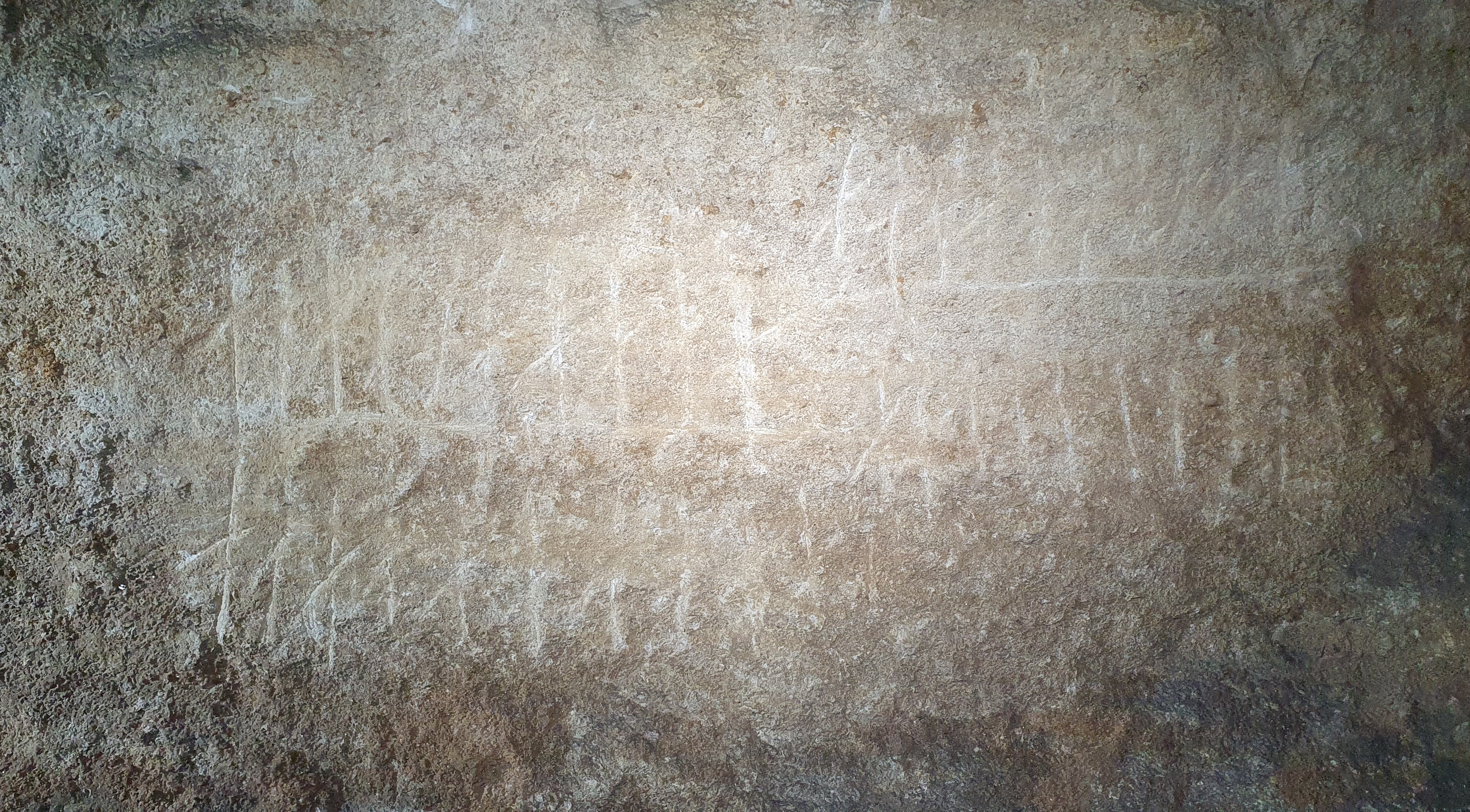
Motorways are notoriously un-photogenic, so have a piccie of miners' tally marks, instead. Masson Mine. Photo by Linda Wilson.
Luckily, despite it being a summer Friday,
the traffic wasn't too bad, and eventually I reached Ashbourne, where I
promptly stopped for a much needed pee and some even more needed tea and
cake. I also had to buy a towel, as I'd forgotten to pack one. Mountain
Warehouse, next to M&S obliged, and armed a nice new travel towel, I
set out on the last leg of my journey, aided by What Three Words, which
took me unerringly to the Orpheus cottage. If you ever need them, the
magic words are: hopes.robots.configure.
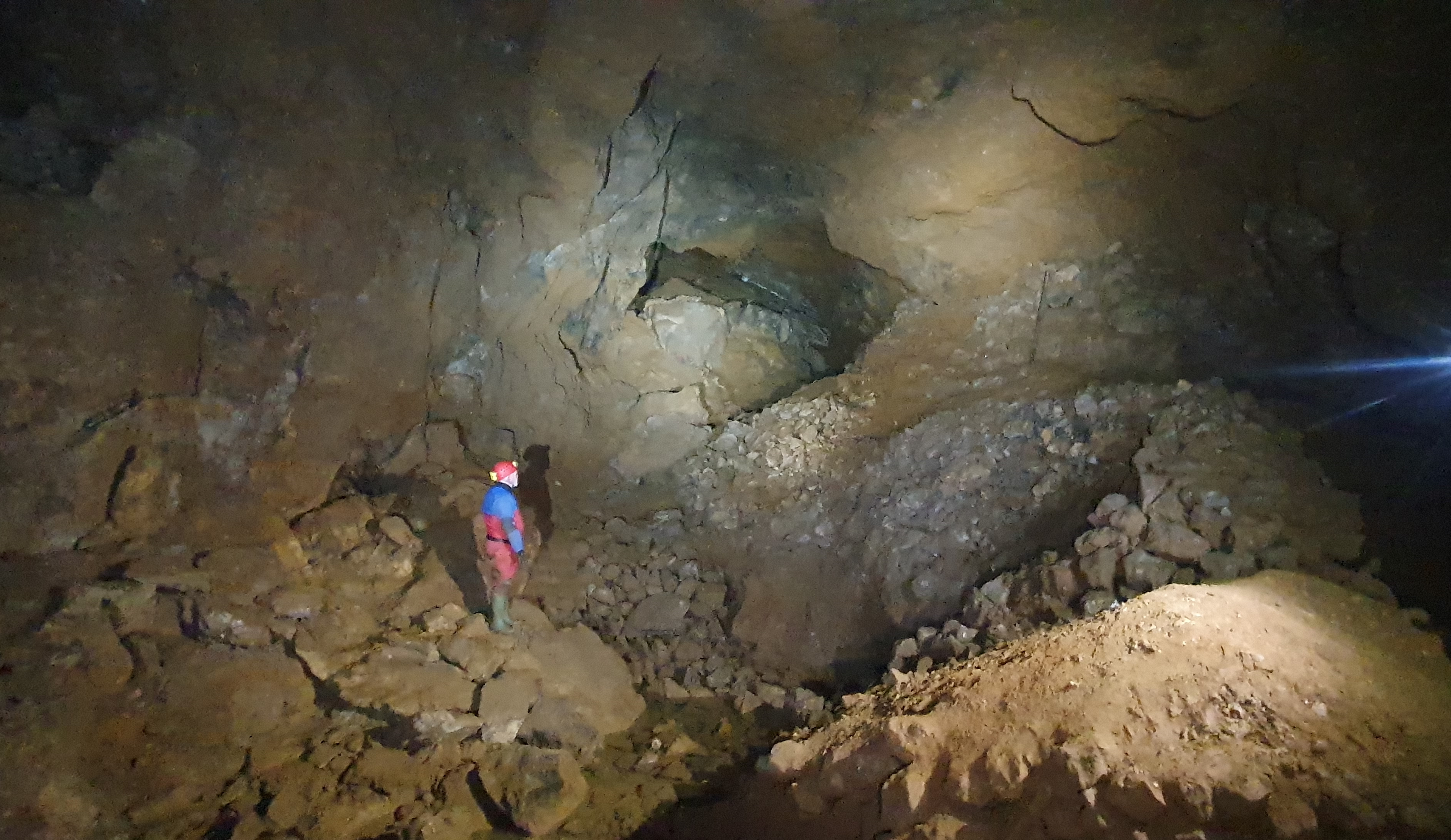
Russell Myers in one of the large chambers in Masson Mine. Photo by Linda Wilson.
Thanks to a very comprehensive set of
instructions from Jenny, I got the key from the key safe, opened the
cottage, turned on all the services, carried out a quick recce of the
premises and made more tea. I then relaxed outside with my sketch book,
enjoying the view.
Next to arrive was BCA chair, Russell Myers and we were later joined by
Jenny Potts in her very smart new campervan. Russell had forgotten to
pack any booze, but I was well supplied with Gordon's Mediterranean
Orange gin and tonic and kind enough to share, so disaster was averted.
We spent a pleasant evening gossiping before bedding down in the
relatively luxurious bunkroom upstairs. The only drawback to the cottage
is the fact that the loo block is separate from the main hut, so if you
need a pee in the night, you have to go outside and trek around the
corner to the loos. Other than that, it's a really nice cottage with
stacks of room.
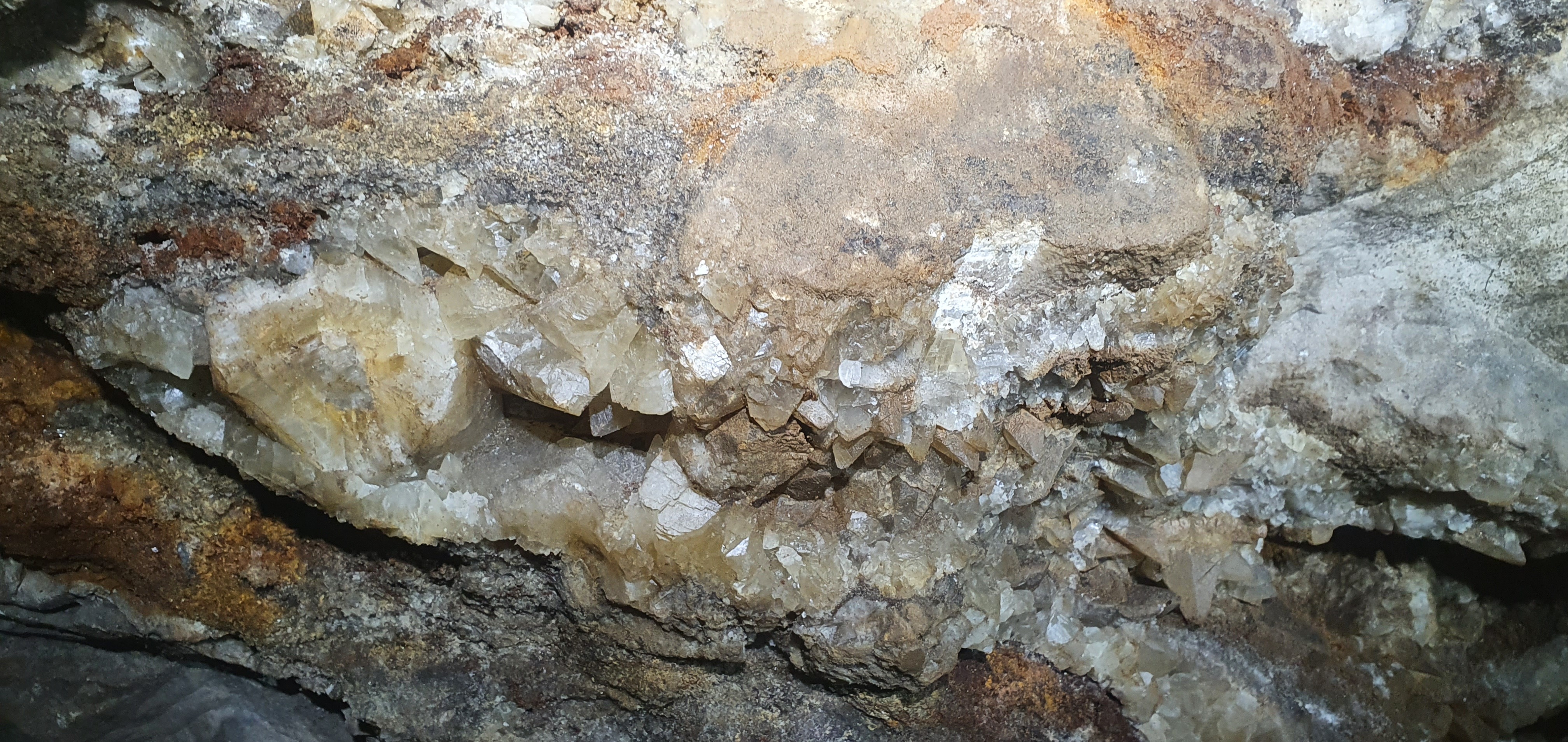
Dog tooth spar, similar to Pen Park Hole, Bristol. Photo by Linda Wilson.
On Saturday, we met up with caver Karen
Slatcher, who does admin work for BCRA and had kindly offered to guide
us around the mine. We were joined by Jo White, another of the BCRA
trustees. The parking for Masson Mine is in a layby on Salters Lane, but
as it's a popular spot for both cavers and climbers, it's advisable to
get there early. A ten minute walk leads to Masson Quarry, which had
climbers everywhere, enjoying the sunshine. Karen rigged a handline on
the entrance slither, which is extremely easy on the way down, but on
the way back, the first manoeuvre is slightly awkward and I was grateful
for both the line and Russell's very steady shoulder.
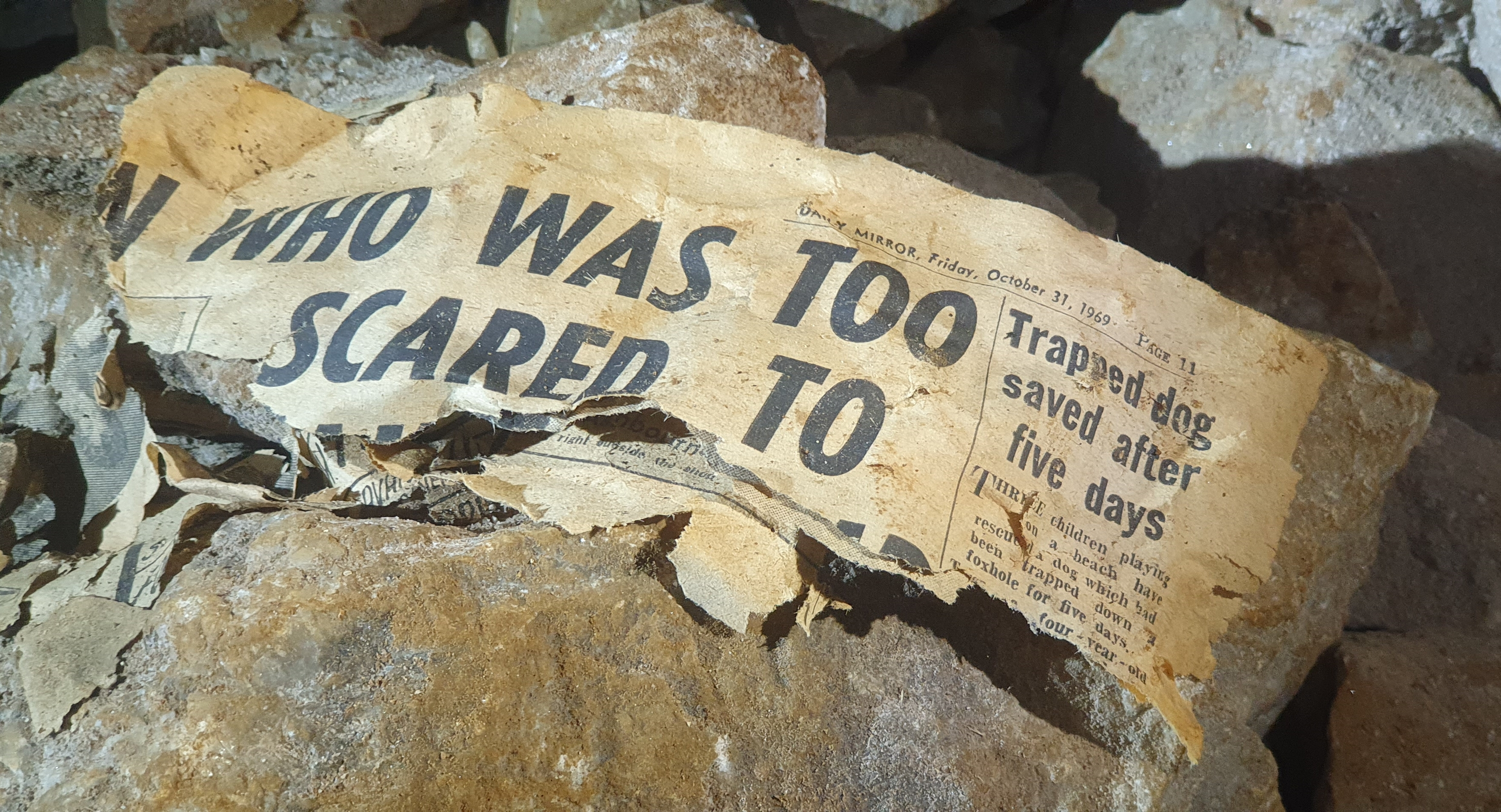
We never did discover who was too scared to do what, or where the dog was rescued from, but we were glad it was OK.
The mine itself is mostly large walking
passage and very quickly I developed a huge, silly grin on my face as I
remembered exactly how much I love that sort of mine. Masson is clearly a
popular beginners' trip but it's big enough to absorb multiple groups
and complex enough to provide a lot of entertainment - and there's loads
to admire.
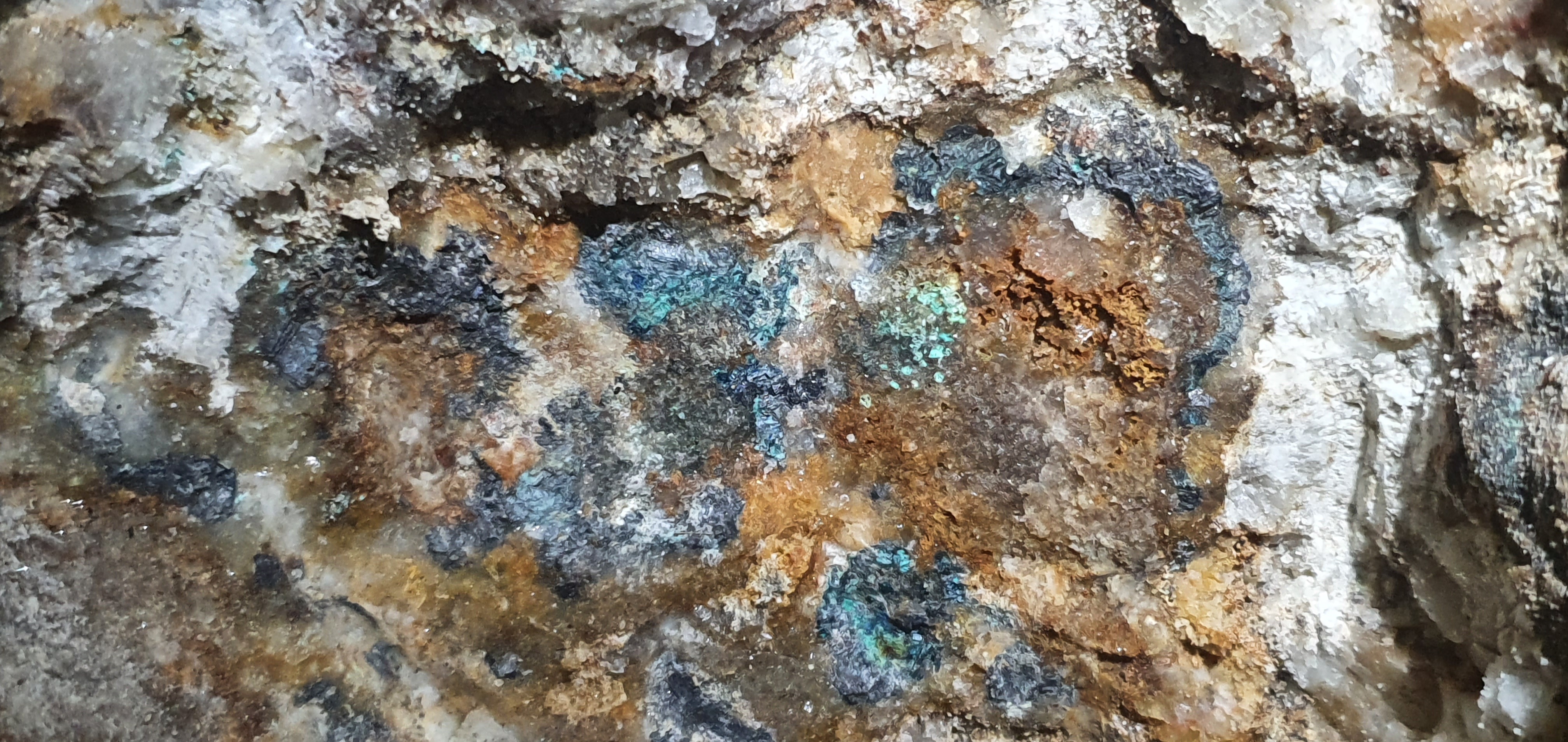
Copper and lead. Photo by Linda Wilson.
I was soon cooing over the pretties,
ranging from stal and cave pearls to large dog toothed crystals, purple
fluorspar, some patches of bright green copper and some yellow/orange
crystals. Masson was mined for lead, with activity from the 15th to the
20th century. The mine connects to the show mine on the Heights of
Abraham, Great Masson Cavern, which can be seen through a gate, but
don't attempt to enter the showcave, as that will jeopardise access.
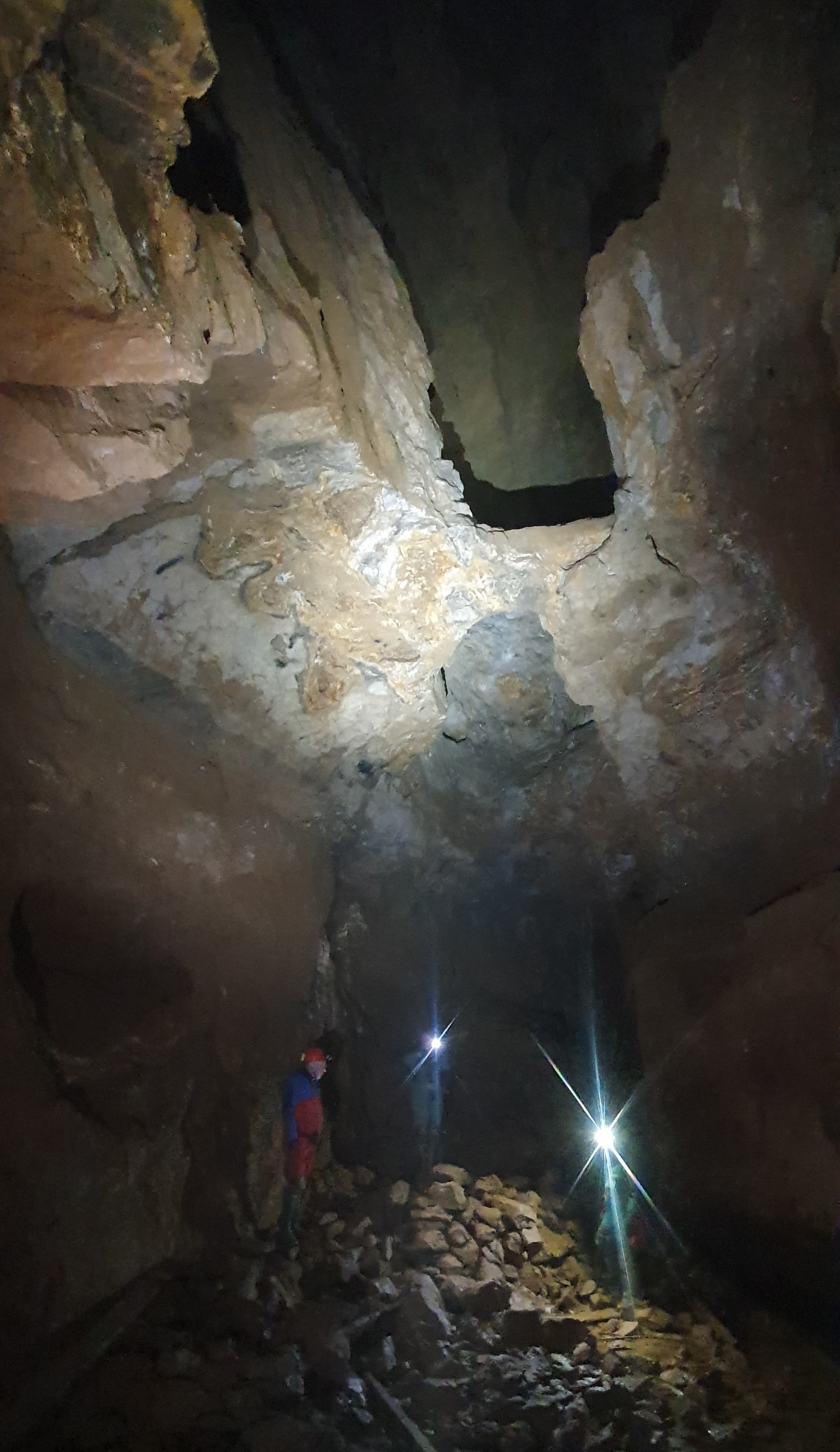
Memo to Self: more lights needed!
We wandered happily around for about three
and a half hours, with Karen as an excellent guide, and they were all
very tolerant of me grabbing as many photos as possible. I'd certainly
love a return visit sometime, and Karen assures me there are other
nicely horizontal mines she can introduce me to. For anyone knackered
from prussicking out of Titan, this would make a very pleasant trip for
the second day of a weekend. We removed a couple of bags of rubbish and -
to my surprise - saw no graffiti, apart from the almost obligatory cock
and balls on a slab outside the entrance.
Nice to make your acquaintance again, Derbyshire! I'll be back.
Linda Wilson
|
|
HONORARY DEGREES FOR THAI CAVE RESCUE DIVERS

Photo-bombing at its best! Back (left to
right): Duncan Price, Dick Willis, Graham Mullan, Linda Wilson. Front
(yeah, obviously!): John Volanthen (left), Rick Stanton (right). Yeah,
we know, we're a bunch of old gits (especially Dick!), but old gits can
be heroes, too!
Rick Stanton and John Volanthen,
the lead divers in the Thai cave rescue received honorary degrees from
the University of Bristol on 6th July 2022, as Linda Wilson reports.
I can still remember the day four years ago when news broke that a team
of 12 young Thai boys and their football coach had been trapped by an
unexpected flood in Tham Luang cave. Along with most cavers (and
probably most other people), I didn't expect to them to be found alive
and, when they were, I certainly didn't expect what happened next. [Film
spoiler - they all survived!] I was certain events in Thailand would
turn out to be the world's worst reality TV show and that we would
eventually see the media spotlight turn on a sad series of small body
bags being removed from the cave. But that's not what happened, and only
a few days after receiving this newsletter, anyone with Amazon Prime
will be able to see the film, Thirteen Lives, directed by Ron Howard,
which dramatises the rescue, with Viggo Mortensen (Aragorn from The Lord
of the Rings movies) playing Rick and John Volanten played by Colin
Farrell.
Over the time of the rescue, I happened to be in a series of meetings in
the university and also attended quite a few graduation lunches as I
was representing the Alumni Association at several of the ceremonies.
Conversations all inevitably turned to the rescue and those who knew I'm
a caver all started to quiz me on what was happening. Our then
vice-Chancellor, Hugh Brady, was particularly interested (as a medic) in
the details of how the boys had to be drugged with ketamine to get them
out of the flooded passages. And so the idea of proposing Rick and John
for honorary degrees was born, and Dick Willis agreed to join me in
nominating them.
To our surprise (as scruffy cavers aren't normally what anyone first
thinks of when honorary degrees from Bristol are mentioned), the
nomination was successful, but the ceremony was delayed due to the onset
of covid-19 and it wasn't until this year that the degrees were
conferred. The ceremony took place in the Great Hall in the Wills
Building, after lunch with the VC and others) and Professor Mike Benton
read the oration. Both this and Rick's response held the audience's
attention, as students stopped fiddling with their mobiles and just sat
and listened.
I had a bird's eye view of the whole thing, as I joined the staff
procession and so was sitting on the stage, behind Rick and John. Graham
and Duncan Price (also a cave diver) attended as Rick's guests, with
Dick there as a nominator, and we were even invited to take part in the
photo shoot afterwards. Then we decamped to Brown's for a much needed
drink. A highlight of the day was Rick and John inadvertently turning up
in identical shoes, this fuelling the epic Hollywood bromance!
The ceremony was live streamed and recorded, and can be watched online. If this link doesn't work for you, let me know and I'll send a download.
The news went viral in the media, too. Thanks go to Steve Warr for sending this screenshot. I even made the BBC news. In my defence, the pompous quote was lifted from the nomination!

And, of course, the day ended with the by now almost obligatory sign of
the times email, with John telling us all that after starting to feel
grotty as the day wore on, he'd just tested positive for covid, but
despite sharing a car and some hugging, the rest of us escaped the
plague.
Linda Wilson
PS If I'd
known the degree was going to be Master of Laws, I might not have
nominated them, as they've now ended up with higher law degrees than
mine, and I had to take exams for mine! But on the plus side, when I
next get asked about something legal in the caving world, I'll just send
the enquirer to Rick and John!
|
|
TRIP ROUND UP
Welcome back to our new shorter
reports section! We're trying to capture as much activity as possible
here, and Zac has even put together a form that you can use to send in
short, or even long, reports for inclusion, so do check out his handiwork here. Any photos can be sent to either Zac or Linda on Facebook or by email if you have any.
WEST TWIN ADIT
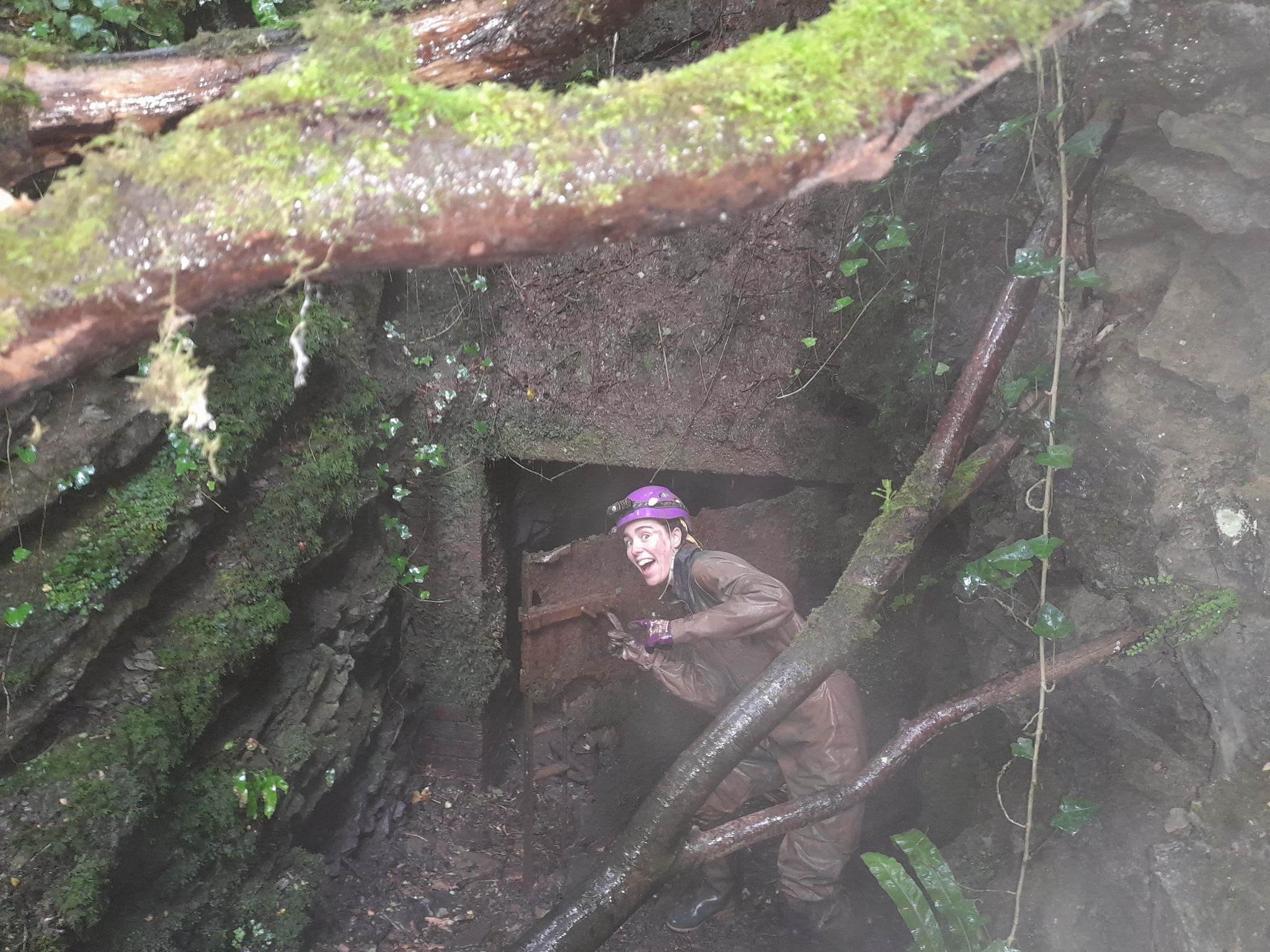
Merryn Matthews in the entrance to West Twin Brook Adit, Burrington. Photo by Henry Morgan.
30.6.22. Henry Morgan, Merryn Matthews. Report by Henry Morgan
Adit'ed to caving! Very cool. A nice walk through the geology of Blackdown.
PIERRE'S POT
30.6.22. Henry Morgan, Merryn Matthews. Report by Henry Morgan.
Checking out the
dig site at the end, quite thoroughly! I found out that my new side
mount light needs more robust cable ties to be suitable for Mendip
caves! We went and looked at the adit afterwards, Merryn enjoyed the
geology!
CANADA COOMBE
1.7.22. Jan Walker, Tony Boycott. Report by Jan Walker
Didn't go down
Upper Canada Cave this time but we had a chance to see some fossils on
the surface with the guide from Avon Wildlife, so the cave will wait for
next trip. Fascinating crinoids in the rocks being used to rebuild the
falling-down dry stone wall. Saw - and drooled over - the entrance to
Bleadon. Really want to go down that one! Star rating was low, only
because it was bucketing down rain and we got soaked!
KENT'S CAVERN

WILLIAM PETRE 1571. Currently the oldest known graffito in Kent's Cavern.
14.7.22. Linda Wilson, Jan Walker. Report by Linda Wilson
Day trip to Kent's Cavern showcave in Devon to discuss the possibility
of taking on a project to record the historic graffiti in the cave. Had a
look at the quantity of material in the cave and agreed to carry out a
pilot study in January 2023. James Hull (general manager) and Elliot
Ling (information officer) are both incredibly enthusiastic about the
project. If anyone would like to be involved in this work, which will
involve access beyond the showcave, please contact Linda.
UPPER CANADA CAVE
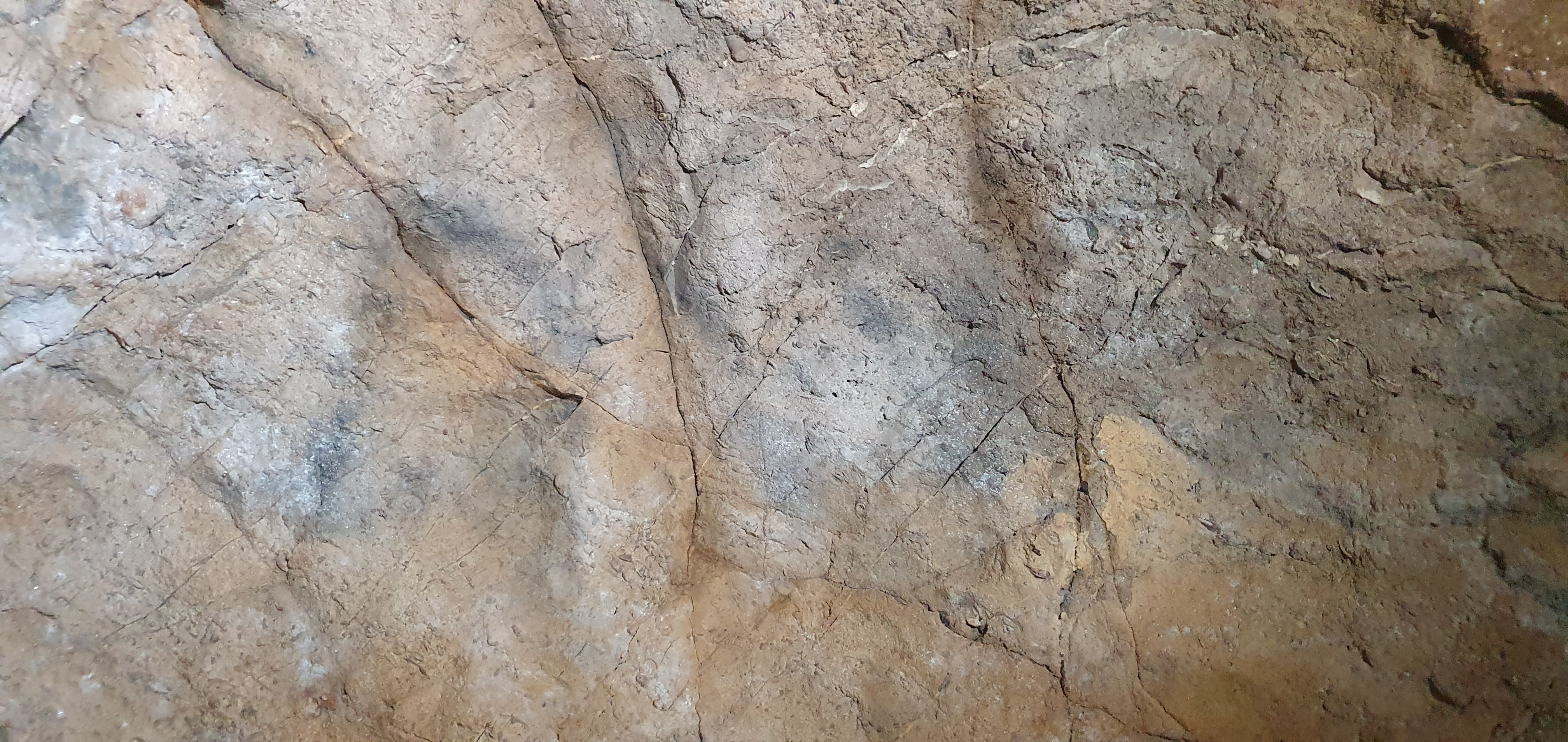
Faded DW graffito in candle smoke, Upper Canada Cave. Photo by Linda Wilson.
16.7.22.
Linda Wilson, Jan Walker, Tony Boycott, Alan Grey (Axbridge
Caving Group) and Lofty (also ACG) Report by Linda Wilson.
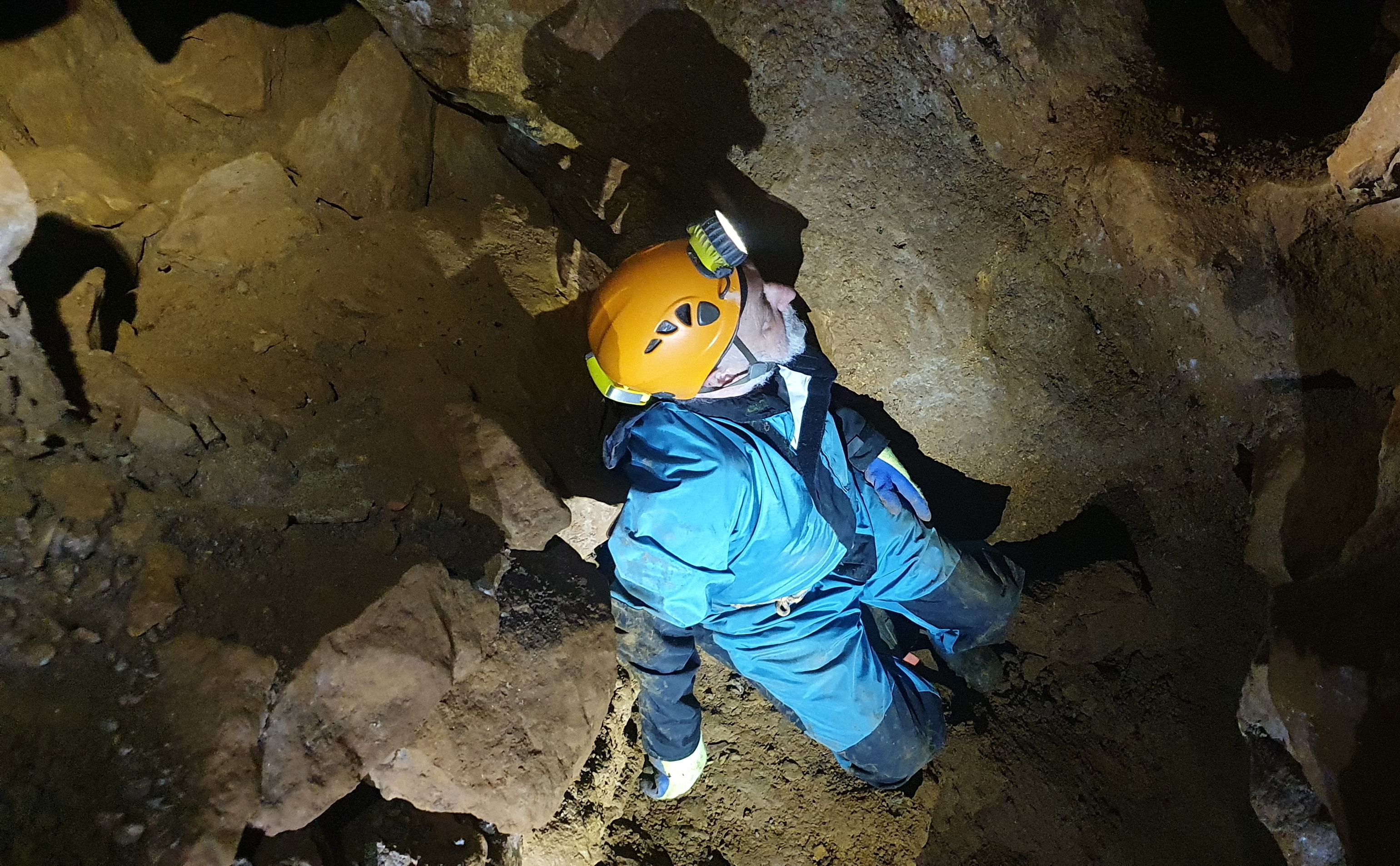
Tony
Boycott in Upper Canada Cave. Photo by Linda Wilson, and yes, she did
send it to his oncology nurse as proof of a resumption of 'normal'
activities.
Short
through trip from Upper Canada Main Entrance to Primrose Cave to see
the DW graffito, faded now due to exposure to the air. These may well be
initials left by David Williams of Bleadon who explored this area in
the 1820s. For more details of the discovery and exploration see this article and survey.
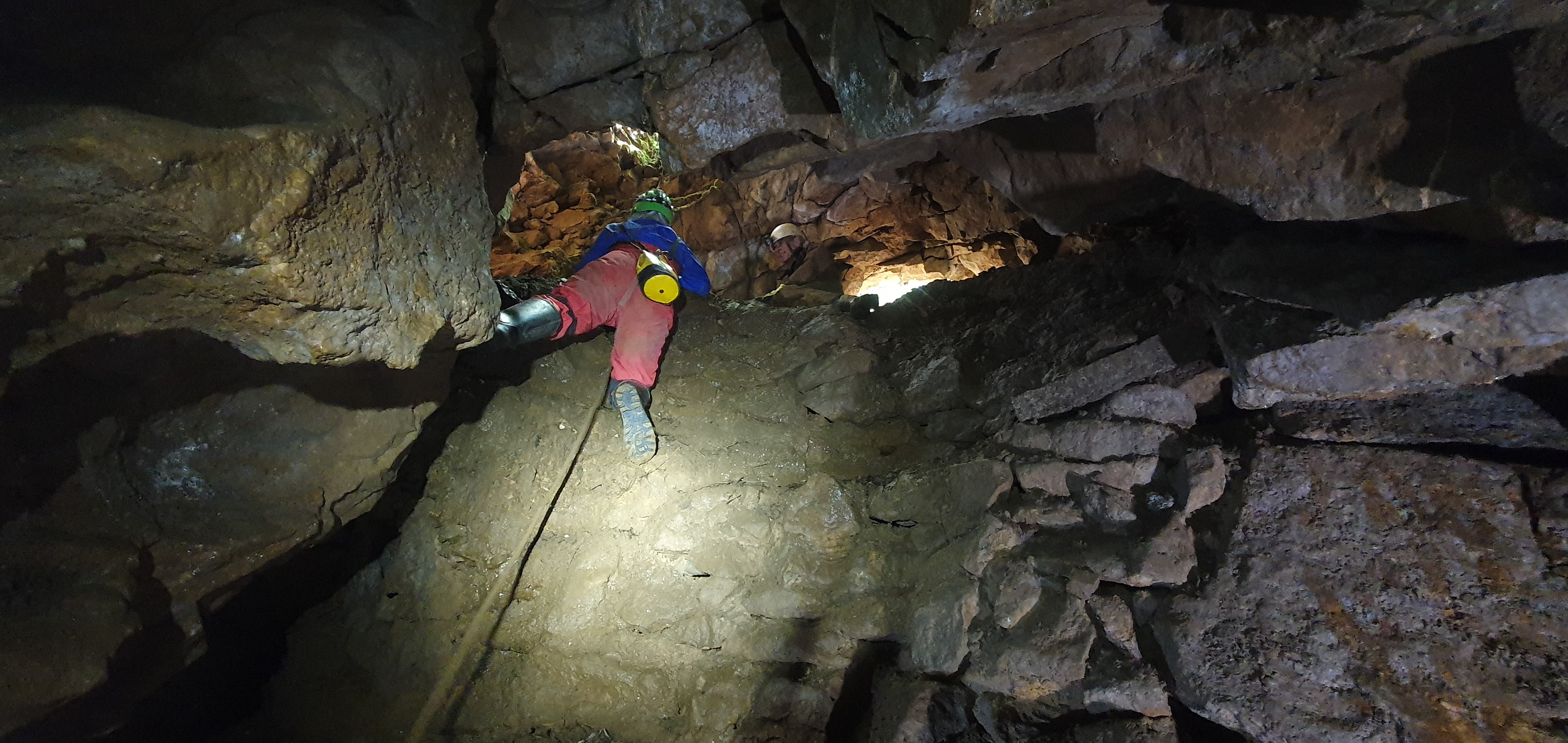
Jan Walker leaving via Primrose entrance, climbing past a stack of original miners' 'deads'. Photo by Linda Wilson.
BLEADON CAVERN
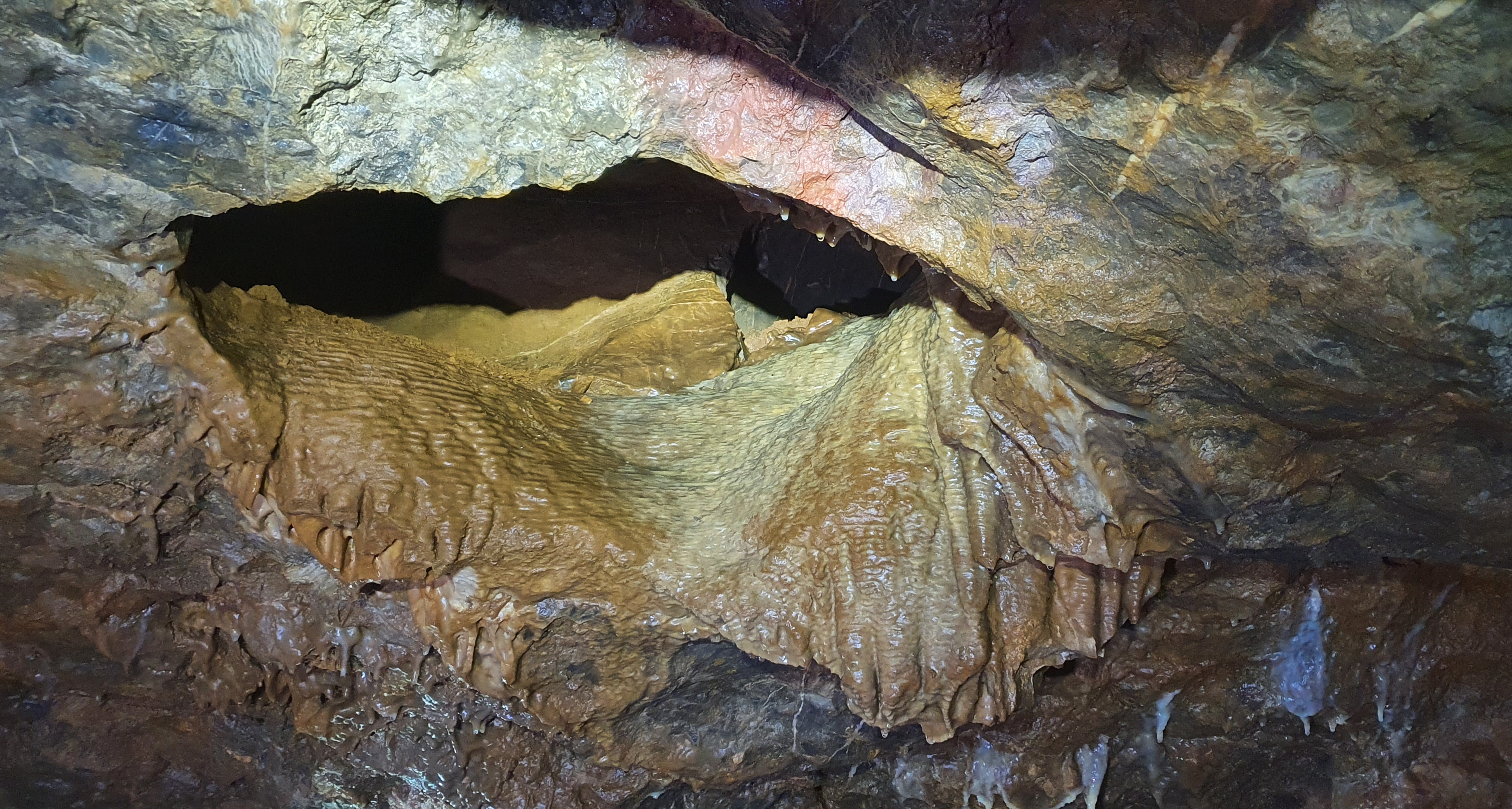
Formations, Bleadon Cavern. Photo by Linda Wilson.
16.7.22. Jan Walker, Linda Wilson, Alan Grey (Axbridge Caving Group). Report by Jan Walker.
Took some time
to get into, as we had to cut the lock off. Note that Alan is
responsible for access to the cave, so on this occasion removing the
lock was wholly legitimate as it hadn't been opened since pre-Covid and
had seized up. Tony Boycott assisted. Once the lock was open, Linda,
Alan and I went down. It's a very steep cave, with three ladders at the
entrance (one outside the gate, and two inside). The first inside ladder
requires you to go through the gate, then close it in order to get
around to reach the ladder. Then down a bit to an almost horizontal
ladder, slightly rickety so it has a rope to hold. Then down a very
slick muddy slope, which for some annoying reason only has a rope at the
top and at the bottom, and not the middle.
I waited at the start of the bottom rope whilst Linda and Alan checked
for the graffiti. They thought they found something, but it wasn't what
had been described. They documented it and then returned, and we made it
back up the slick bit, with Alan leading and then providing a very
handy boot to hang onto so short me could get through the bit that
doesn't have a rope. We then returned to the place where the mudslide
(snark) started, and went into an upper passage instead. Result. There
was a black inscription dated 1746. Linda took photos whilst Alan held
her belt and I braced her feet, since she was right by the edge of a
rather nasty hole. Came out tired, but flushed with success, to be
greeted by Tony Boycott with sandwiches and tea.
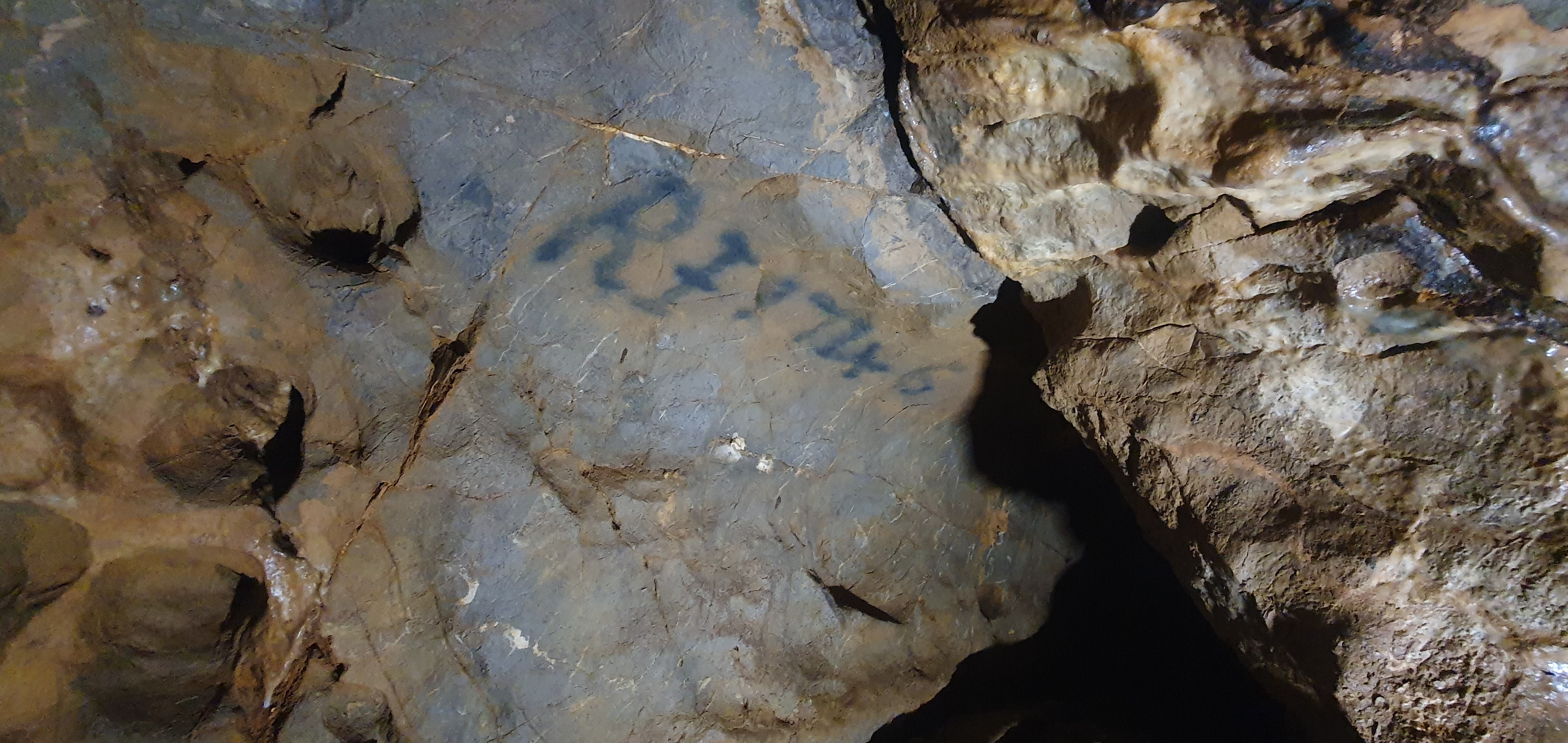
Initials and date in candle smoke, RI 1746, in Bleadon Cavern. Photo by Linda Wilson.
Note from Linda Wilson:
While Alan was searching for some historic graffiti he'd been shown a
while ago (which eluded him), I noticed a previously unreported graffito
which appears to be the initials HE (or F). The covering of stal shows
that this is certainly not recent! The width of what appears to be
candle smoke is similar to the more well known initials and date
referred to above.
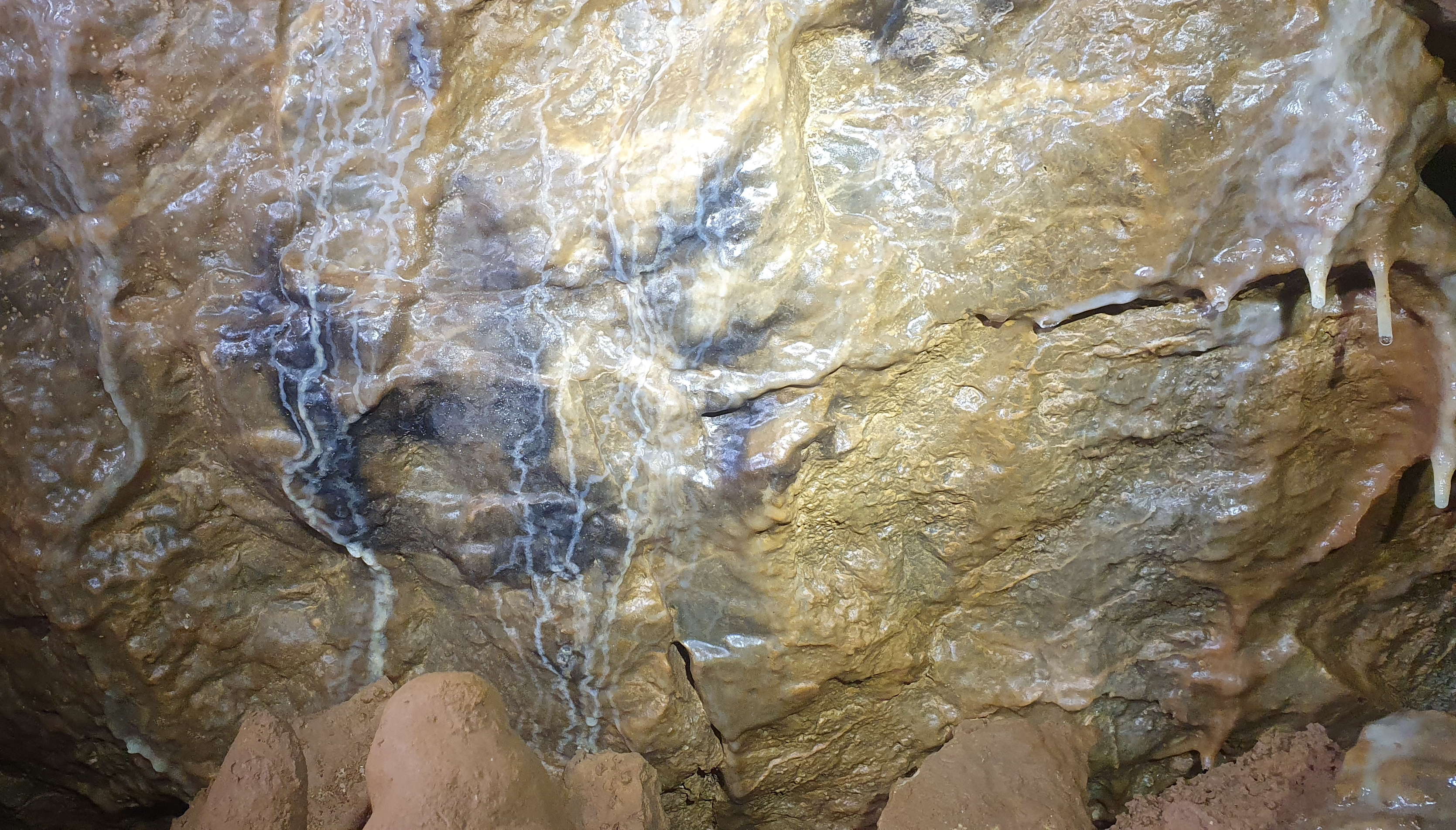
TOP SINK, LONGWOOD VALLEY
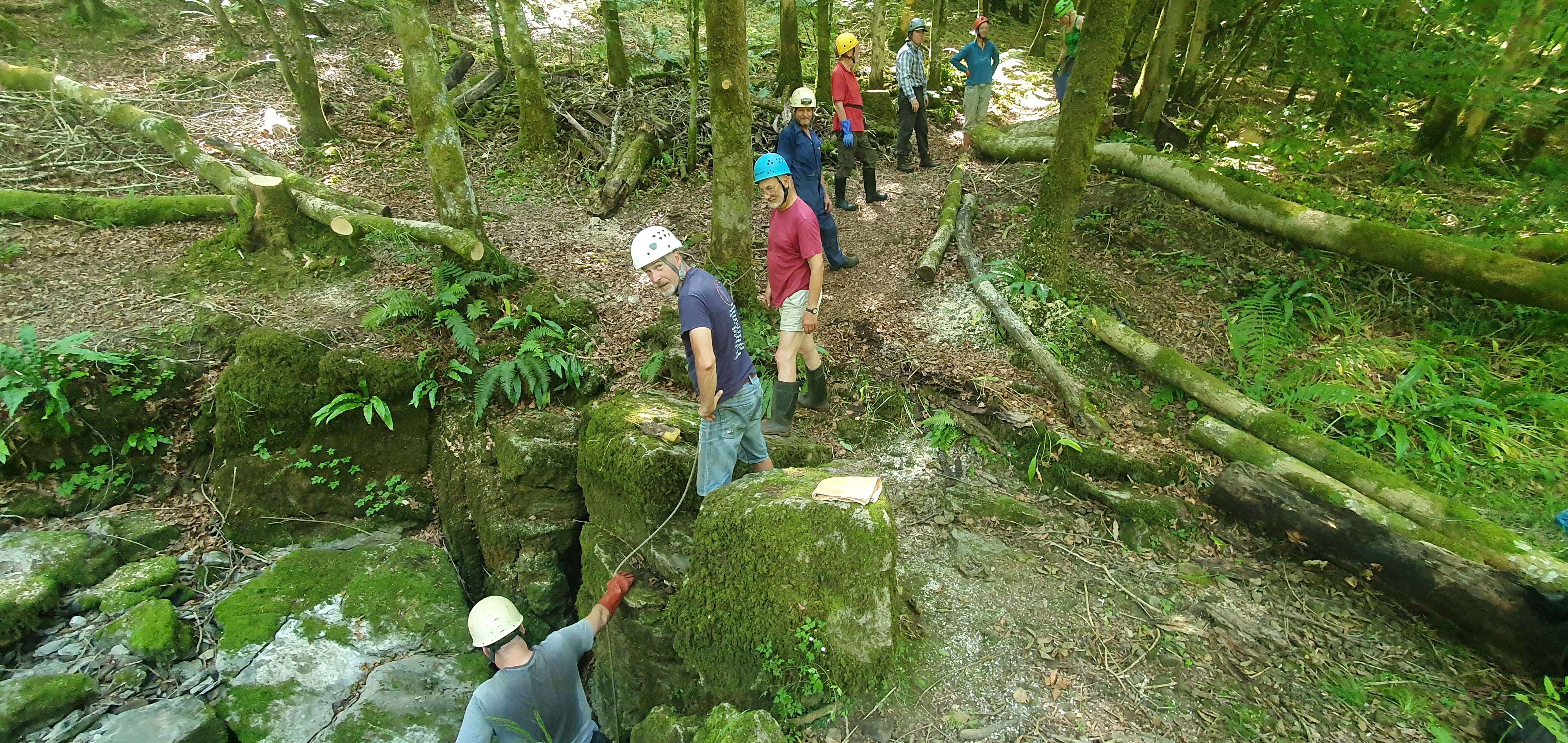
When in a hole, keep digging! Photo by Linda Wilson.
19.7.22.
Linda Wilson, Jan Walker, Ali Moody and a cast of thousands, aka nine
assorted cavers from the Wessex, the MNRC and Chris Eyles (Somerset
Wildlife Trust). Report by Linda Wilson.
Concerned Friend: "It's going to be the hottest day of the year tomorrow. Are you sure this is sensible?"
Me: "Yes, I know, and no, it's not."
Concerned Friend: "Are you going to call it off?"
Me: "Nope. Too hard to rearrange."
So armed with digging kit, plenty of fluids, packed lunches and cakes,
we toiled hard for three and a half hours clearing Top Sink of a year's
worth of assorted flood debris consisting of rocks, mud, sticks etc in
almost archaeological layers. A human chain hefted digging skips to the
spoil heap.
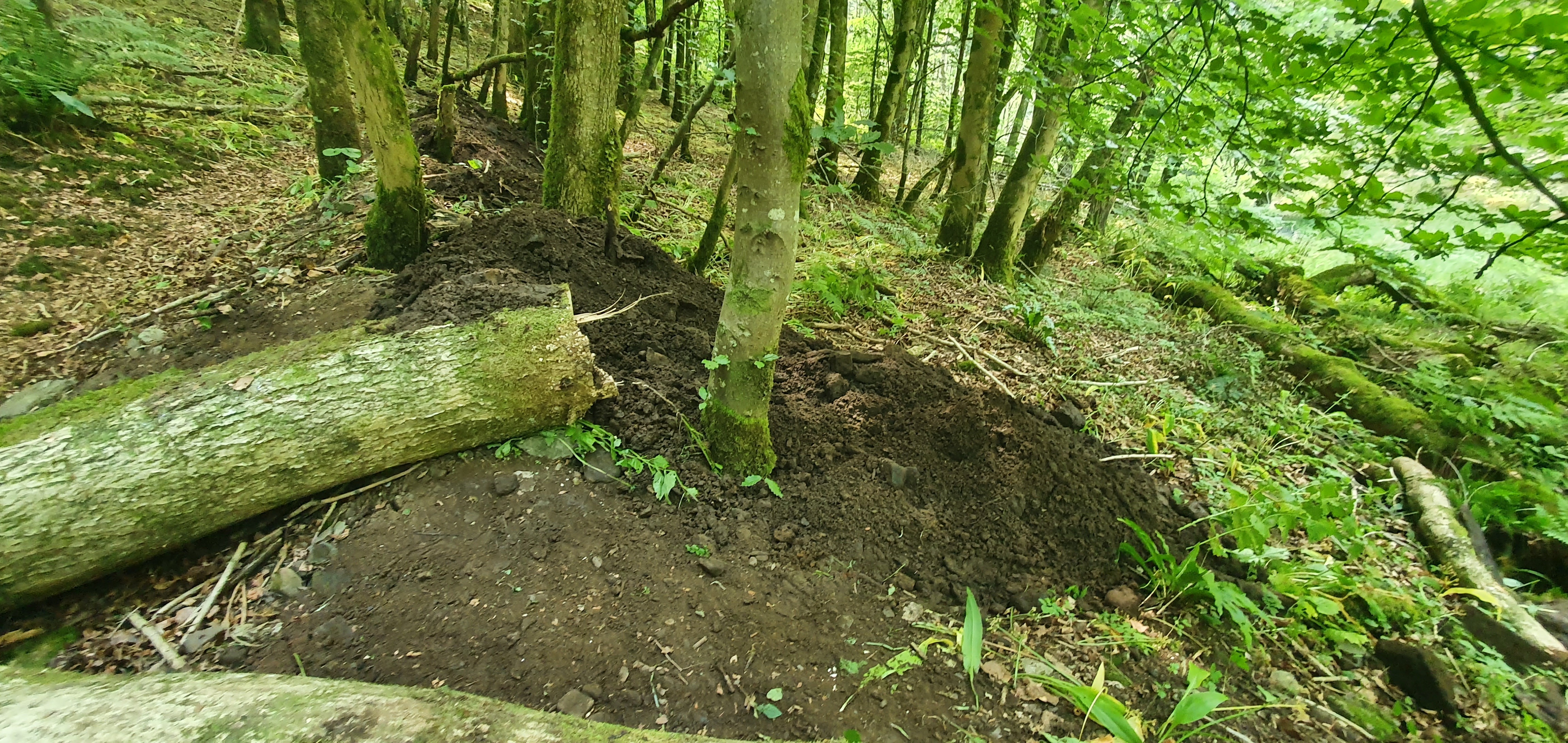
Fresh spoil on top of old heap. Photo by Linda Wilson.
The
good folk of Cheddar can now sleep more easily in their beds as when
dug out to this extent, Top Sink can take most of the winter rain, with
occasional overflows getting as far as Longwood Valley Sink, but not
reaching (and damaging/closing) the road through Cheddar Gorge. I
organise this every year wearing my Charterhouse Caving Company Ltd
conservation officer's helmet. To comply with the latest access
requirements, we wore helmets at all times in the wood. Legions of
biting insects harried us the whole time, but I discovered that
drenching myself from head to foot in Deet before leaving the house did
help!
|
|
ACCESS NEWS - OGOF CRAIG A FFYNNON
The following message from the Cambrian
Caving Council (CCC), the regional caving body for Wales, not to be
confused with CCC Ltd, the access body that deals with the Charterhouse
caves on Mendip - yeah, we know, too many similar acronyms! - has been
passed on by Clive Owen, UBSS rep on CCC. We've expanded the acronyms via square brackets [and red, proving that Henry isn't the only one who can colour code things!]
Cambrian Caving Council has decided to change the padlock at Ogof Craig a
Ffynnon. There are 30+ official keys in circulation mainly held by
clubs and going back maybe 20 years.
The new lock will be the same key as fits Ogof Cnwc (the Daren Cilau
No.2 entrance) itself in use for 10+ years and should be installed
sometime on Monday 18th July. There are also 30+ keys in circulation for
Ogof Cnwc. So on 18th July you would need to take both old and new, and
thereafter just the new one. Clubs or cavers wanting keys should
contact Malcolm Reid (the former MLCMAC [Mmyndd Llangatwg Cave Management Advisory Committee]
access officer) or get one through Chelsea Speleological Society
(Adrian Fawcett or me). Groups staying at Whitewalls can be provided
with a set of local cave keys for the duration of their stay by prior
arrangement.
An update on MLCMAC. [Mmyndd Llangatwg Cave Management Advisory Committee]
The former cave management committee was effectively left in limbo when NRW [Natural Resources Wales]
withdrew from funding, running and chairing it. The group has now been
adopted by Cambrian Caving Council where the plan is to let it run as a
subcommittee comprising its previous members (but not NRW staff) and
welcomes anyone else expressing an interest in helping look after the
caves on its patch. NRW's cave management agreement with the landowners
(Beaufort Estate) essentially ended when NRW defaulted. The established
position of the estate, as stated to me in various meetings over the
years, is that they approve of responsible bona fide caving activities
on their land and cavers themselves must assess what 'responsible'
implies and act accordingly. We hope to be able to re-affirm this simple
and pragmatic position in a meeting with the estate later in the summer
and reach a clear understanding with them that CCC will take
responsibility where NRW left off.
Stuart France
Conservation and Access Officer
Cambrian Caving
Two weeks later, the lock and gate were deliberately damaged and
so at present, there is no access to the cave at all while repairs are
carried out. We'll update on this as soon as we can.
|
|
CAVING IN NORTHWEST SCOTLAND
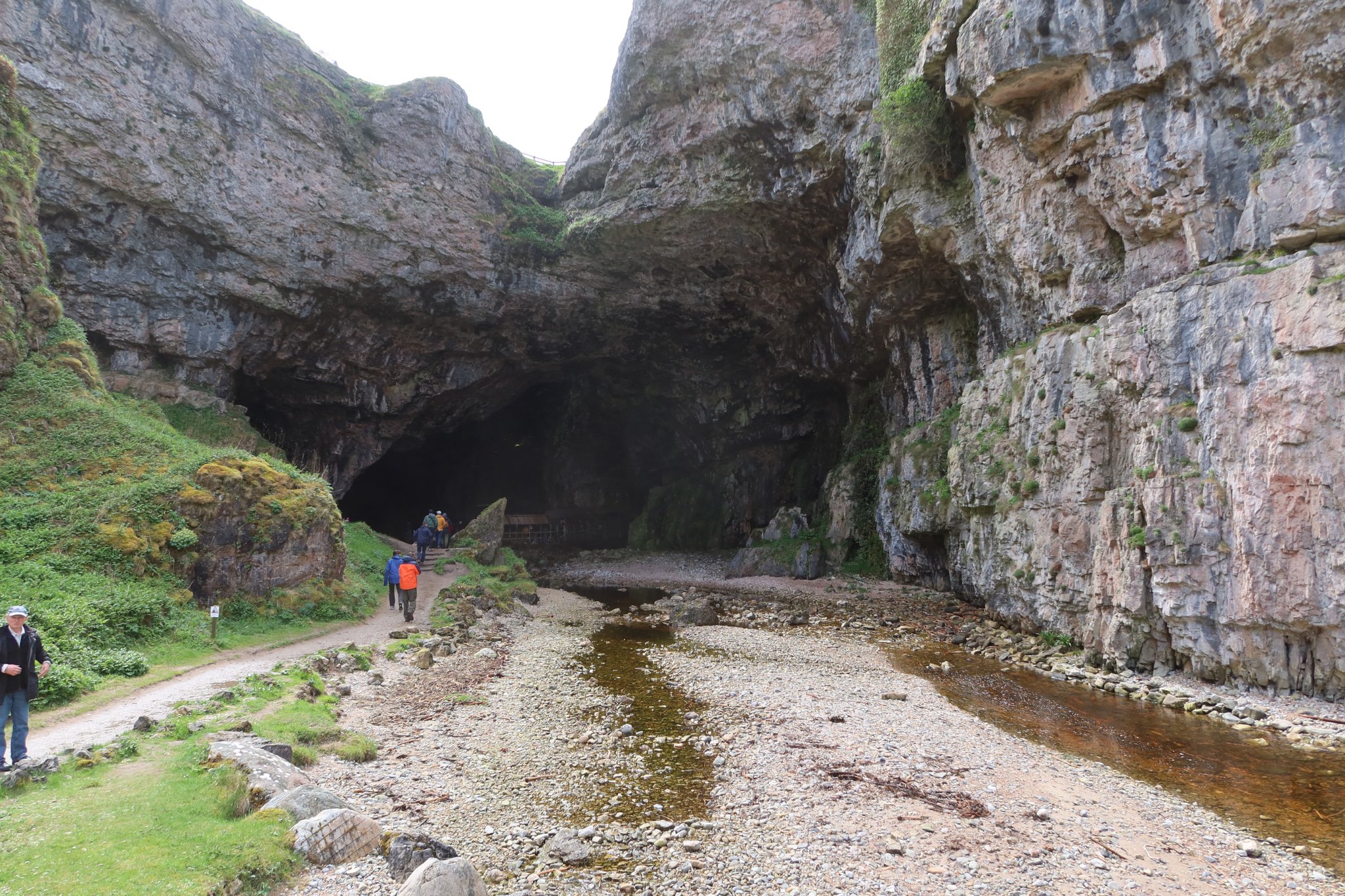
The resurgence tourist entrance to Smoo Cave Durness. Photo by Mark Tringham.
Mention Scotland and lochs, fine
mountain scenery and whisky come to mind, but caving? Seriously? Well,
the short answer is yes! Mark Tringham, a member of UBSS, GSS
(Gloucester Speleological Society) and GSG (Grampian Speleological
Group), has provided an account of some of the excellent trips awaiting
anyone who ventures north of the border.
There is much to satisfy the speleological interest of those willing to
pass by the Yorkshire Dales and keep going a long, long way further. The
Northwest Highlands have an intermittent tract of Cambrian aged
limestone and dolomite found from around Skye right up to the NW coast
at Durness as well as Jurassic limestone centred on the Isle of Skye and
these areas host the majority of the known caves.
I had my first brush with this area as a 20-year-old geology student
when we were taken to the Assynt district see what is one of the UK’s
most scenic areas with the most amazing variety of rock types,
stratigraphy and geological structure. Then much later as a geologist
working in Aberdeen it was a natural for me to join the principal club,
the Grampian Speleological Group (GSG) and spend many weekends and
longer breaks staying at the club hut at Elphin, just to the north of
Ullapool, right in the heart of the caving patch.
So, in May 2022, many years later, I led an enthusiastic group of five
others from the Gloucester Speleological Society (GSS) to stay for five
days and enjoy the caves there. Most had not caved there before, so we
hit the high points for our four days caving and two half days mountain
walking. Assynt has many mountains many reaching between 2,700 and 3,300
ft in height and is also close to the bracing Atlantic coastline and
thus provides an excellent all-round out-door experience on top of the
caving.
The drive from Gloucester is about ten hours and 500 miles distance and
we stayed as guests of the GSG at the Elphin Caving Centre for five
nights. May is often the best time to visit because of better weather,
long day-light hours and few, if any, problems with the dreaded midges.
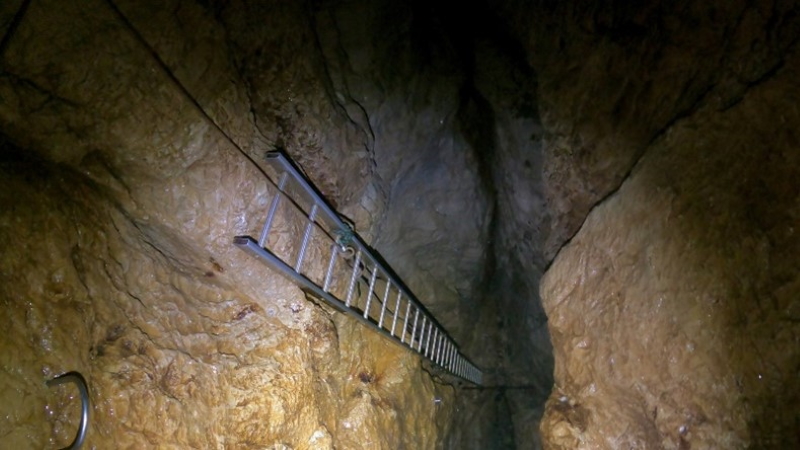
Fixed ladders in the entrance pitch of Rana Hole. Photo by Andy Ley.
On caving day one, the group decided to
tackle the hardest sporty caving trip of the week. This involved walking
up Allt nan Uamh (Stream of the Caves) fighting up the valley against a
very strong wind for an hour or so before descending Rana Hole, which
is part of the Claonite system. At 3.4 km long and 110m deep this is the
longest cave in Scotland. Rana Hole was dug out over the course of many
years of effort by GSG to gain access to the downstream part of
Claonite beyond a series of sumps.
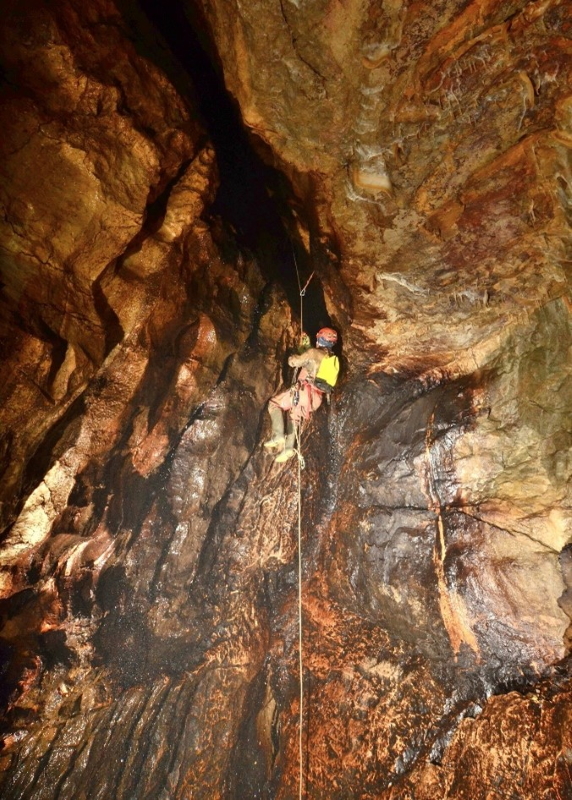
Black Rift pitch Rana Hole with Ian Crossland on the rope. Photo by Mark Tringham.
Rana starts with some acrobatic fixed
ladders, climbs and squeezes, passing some large and well decorated
chambers and then an SRT rope descent of Black Rift near Belh Aven where
it joins the major Claonite trunk route with a large rumbling streamway
and relict dry passages and chambers. These end near The Great Northern
Time Machine (photo) a truly massive passage and near to where bear
skeletons and reindeer remains were found by the original explorers.
These have now been transferred by GSG to the Museum of Scotland for
study and safe-keeping. The GSS team had a good romp around the lower
part of the cave, took some photos and were well satisfied after about
six hours underground.
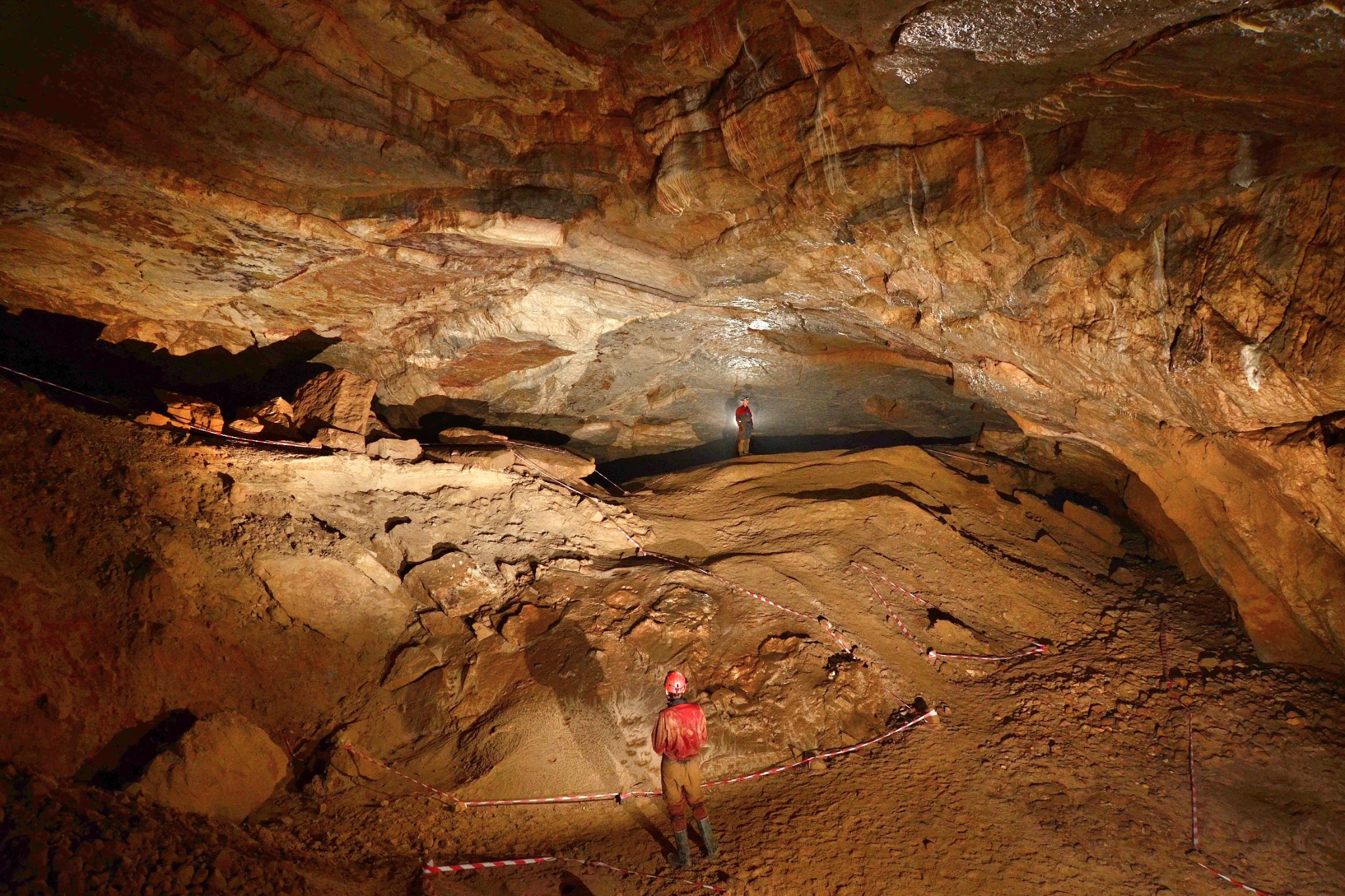
Uamh an Claonite, the Great Northern Time Machine. Photo by Mark Tringham.
An easier day followed with a visit to Cnoc
nan Uamh (Hill of Caves), which is a favourite for beginners. This is a
1,750 long and 83m deep cave system, but for the most-part is
horizontal. Like most of the other caves in the region it involves about
45 minutes walk from the road-side parking place. With three entrances,
the system contains a fine mixture of gushing streamways, large
chambers, some of which are well decorated with formations, and short
squeezes. In the upstream direction Cnoc nan Uamh Stream Cave –
otherwise known as Cnockers – forms the majority of the system that can
be followed without diving. This was explored via three chambers with
connecting crawls and cascades to Far Passage, which is a flood overflow
route (photo) leading to a static sump. Landslip Chamber is the biggest
of the three and photos were also taken here on the way out while some
team members went off exploring the numerous looping side passage
crawls.
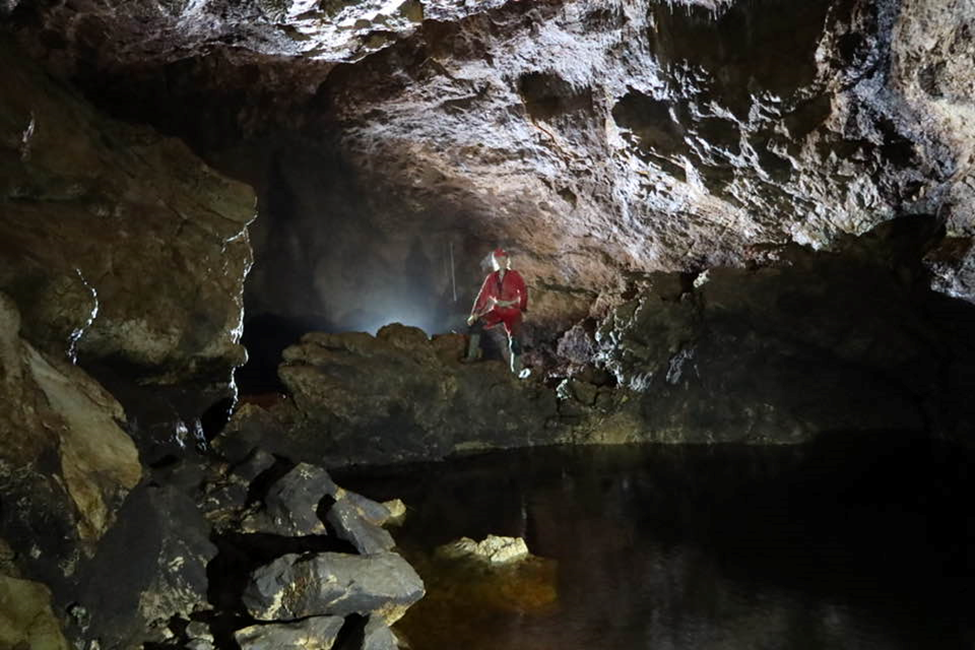
Landslip Chamber, Cnoc nan Uamh, with Juli Durber. Photo by Mark Tringham.
Downstream Uamh Tartair (Roaring Cave)
forms a broad ramp passage with a long cascade eroded out along a thrust
fault plane. Many of the caves in this region have formed along such
low angle fault planes, a feature almost unique to this part of the UK.
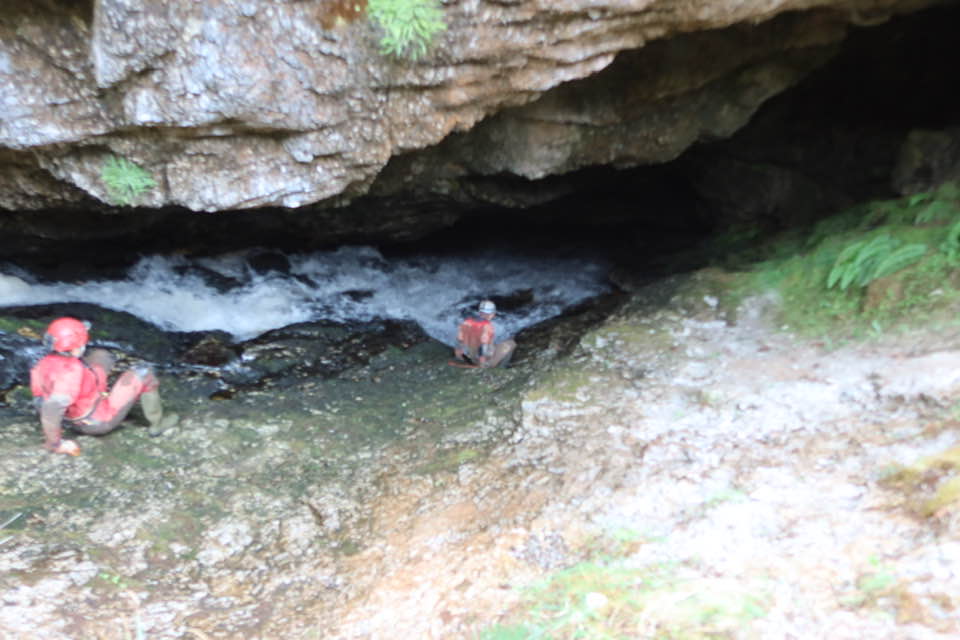
Uamh an Tartair, water slide eroded out on thrust fault plane. Photo by Mark Tringham.
After these two fairly ‘full-on’ caving
days completed and with a good weather forecast on Day Three the GSS
team decided to take the 60 mile scenic drive north to Durness for some
coastal walking and a visit to the world-famous but short Smoo show
cave. The drive passes through exciting scenery with steep mountain
peaks, numerous fresh and saltwater lochs and finally the sea cliffs and
beautiful sandy beaches around the village of Durness. I had already
contacted the show cave operator and GSG member Fraser Eadie concerning
caver access to the show cave and the team went first to Smoo to speak
to him and arranged a return later at 4pm after tourist access had
stopped for the day. The pothole entrance was checked and looked quite
intimidating with a large stream flow and strong wind draughting in and
down, whipping up the cascading water into a fine spray. The GSS
objective was to descend the waterfall pothole entrance, which is about
30m deep, drop into Second Chamber, swim around into Third Chamber and
swim out of the resurgence to First Chamber. First Chamber opens to the
sea cliff and is a spectacular sight. Tourists currently pay £10 for the
privilege of an inflatable boat ride around 2nd and 3rd
Chambers as well as receiving a scientific explanation from Fraser.
Since the boat ride involves travelling beneath the pothole entrance the
abseil in has to be outside opening hours for tourists.
Next, the craft village at Balnakeil was visited just on the other side
of Durness village for a café lunch and look around the various shops
and a small geological museum. Balnakiel is a disused RAF base that was
an important northwestern-most UK mainland airfield, used during World
War Two for North Atlantic sorties. Part of the old base was once a
Glasgow University field studies centre and I had stayed there for a
week during my undergraduate geological trip mentioned in the
introduction. The team also enjoyed an hour or two beach walk at
Balnakiel, going out northwards towards Faraid Headland.
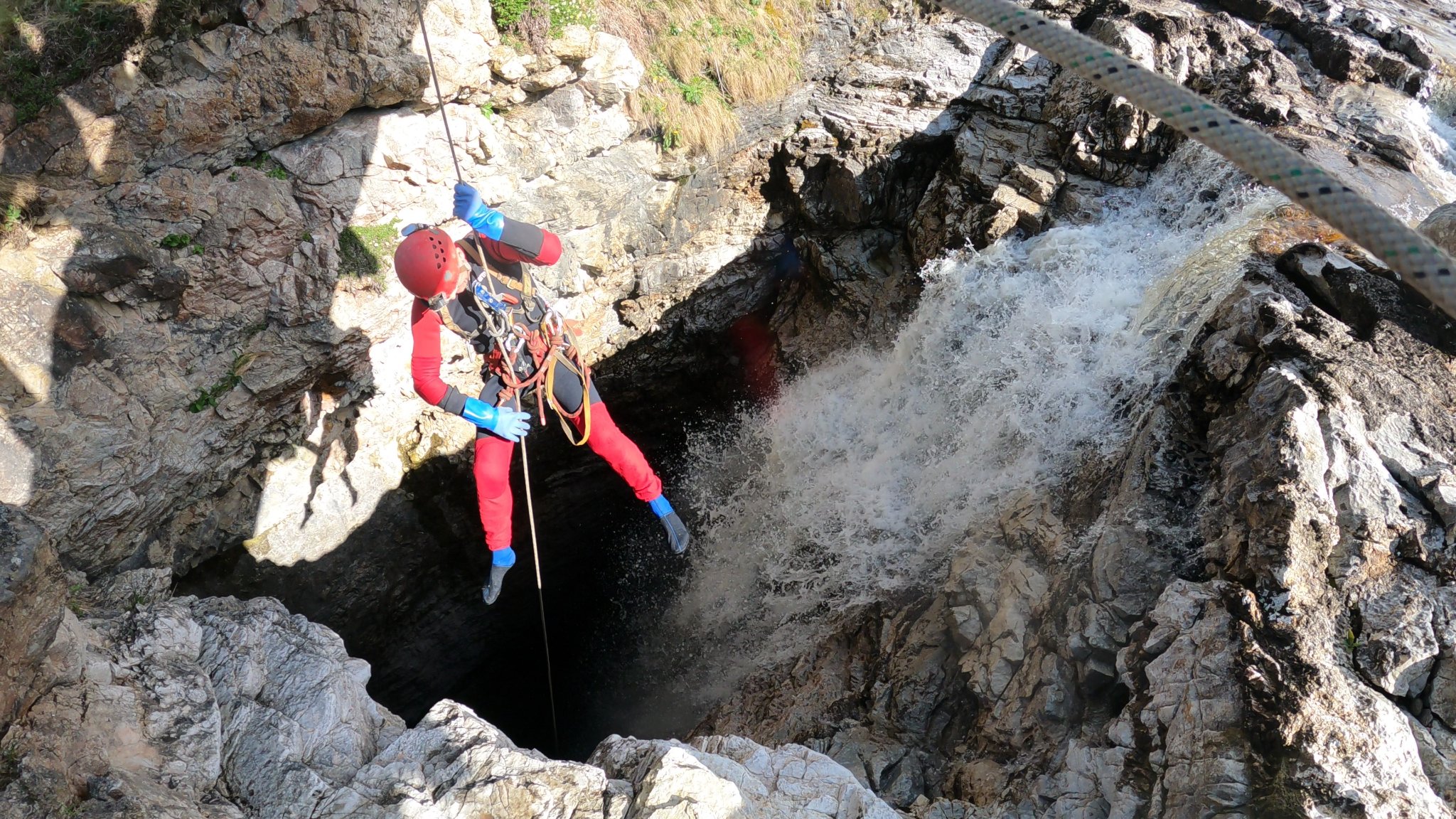
Descending into Smoo Cave. Mark Tringham on the rope. Photo by Andy Ley.
On returning to Smoo we found the show cave
closed, the water still flowing strongly down the pothole entrance, but
the windy conditions had abated. We therefore set about rigging the
rope in, belaying to a modern wood and steel bridge that spans across
the pothole entrance with a traverse line and single vertical drop just
to one side of the main waterflow. Three of the team tested out the
route without difficulty and had massive fun on the airy abseil and swim
around and out, followed by a walk back up the tourist footpath. After a
few goes the rest of the team joined in and found the descent and short
through trip very exciting. The trip back to Elphin took about 1 ½
hours in the beautiful evening light with majestic views out to sea and
inland to the nearby craggy mountain peaks.
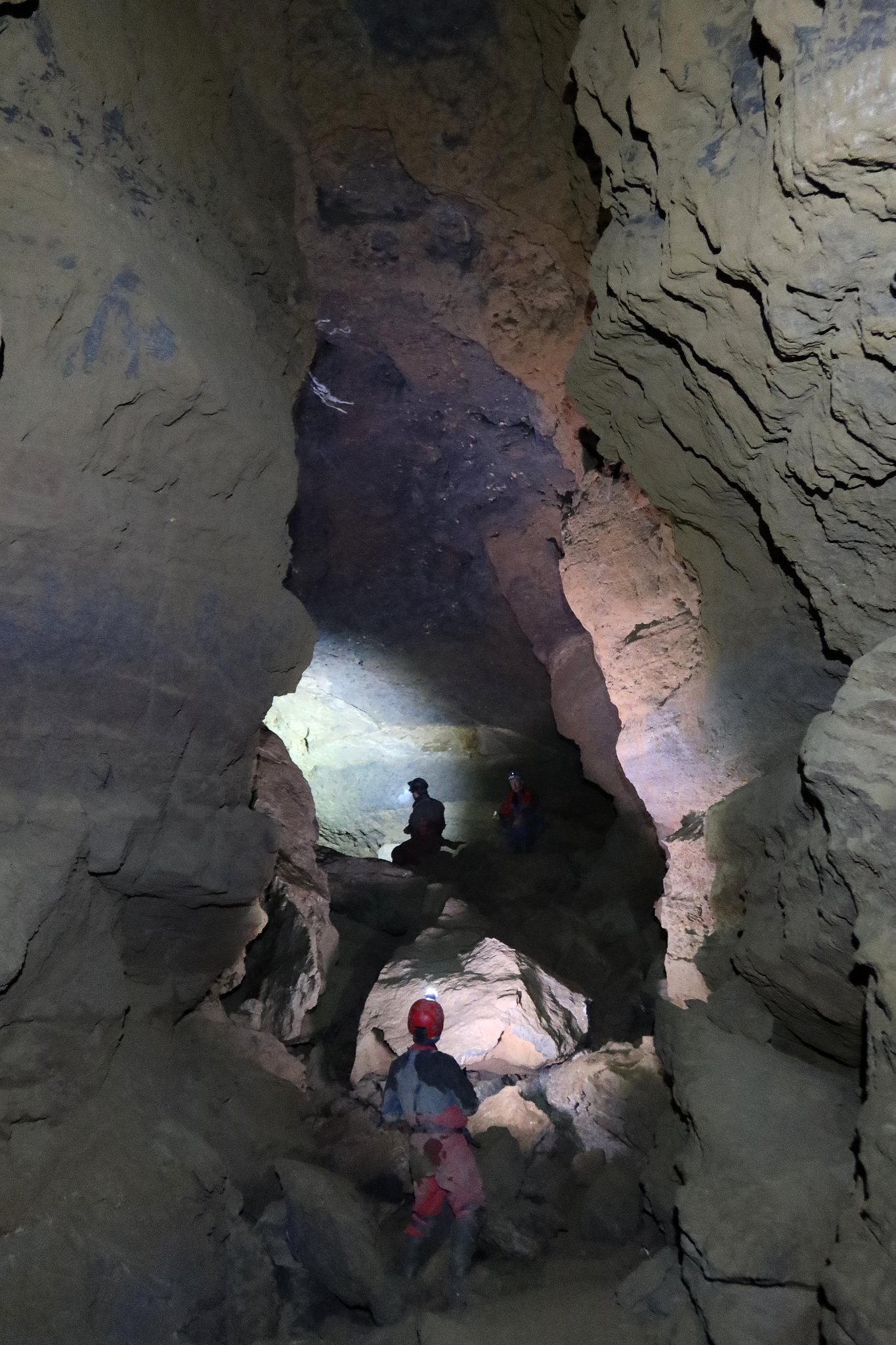
Allt nan Uamh Stream Cave Main Passage. Photo by Mark Tringham.
The fourth day of caving took the team back
to Allt nan Uamh, but this time to visit the Stream Cave (ANUSC) which
is around 1500m long and 40m deep and then followed with a visit to a
relatively new cave dig at nearby UNCABAC, presently 175m long. The
ANUSC was fairly fully explored and photos taken with a fine streamway
coming and going from various large dry routes leading down to a sump
and splashy boulder digs. A short tight wet squeeze leads into the
upstream part of the cave with some exhilarating climbs and traverses
above the streamway (photo) before another inlet sump was reached. After
exiting the cave most of the team had had enough, but I was determined
to take a look at the UNCABAC dig, which has featured in GSG news for
several years now. The entrance is in the stream-bed and had to be
uncovered from its protective boulder and plastic barricade before entry
could be made (photo). The first part of the cave was found to be very
muddy and narrow but further in it became larger and cleaner with a few
chambers and passages large enough to stand up in before termination in a
small rift where banging has been in progress to try and extend the
cave.
The team celebrated a successful and fun four days caving with an
enjoyable evening meal out at the Alltnacealgach Inn a few miles from
Elphin. A clean-up at the GSG hut was done the next morning, followed by
a few hours’ mountain walk up the popular Stac Polaidh peak and then
the team dispersed on various onward routes home. Everyone had a great
time and enjoyed staying at the excellent GSG hut and felt
well-satisfied with four days of varied and challenging caving as well
as being so impressed by the magnificent scenery in this remote part of
the UK. This was the first ever GSS club trip to Assynt and based on
everyone’s response it’s unlikely to be the last.
Mark Tringham
|
|
CAVES OF ASSYNT
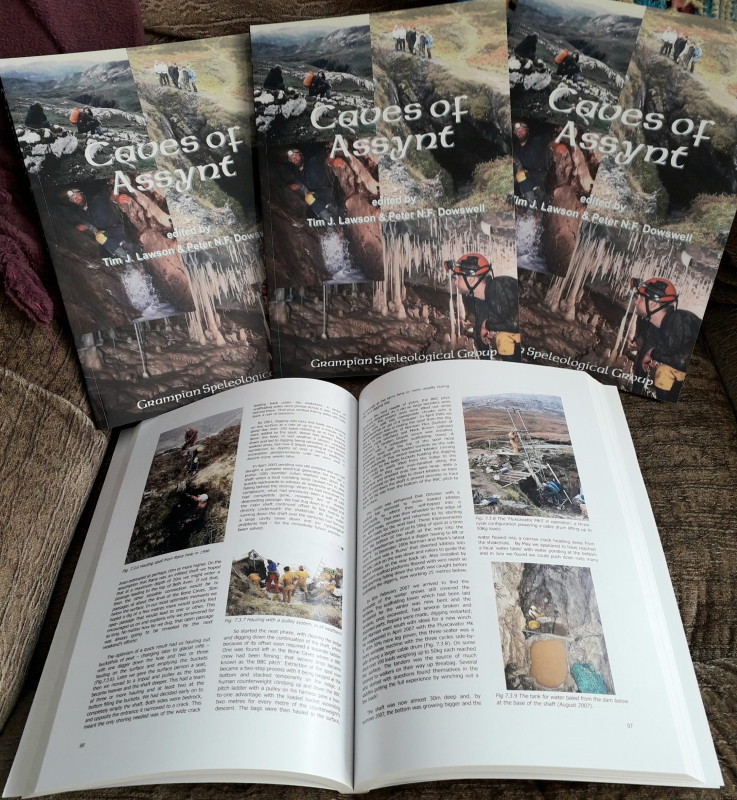
And for anyone who's been inspired by Mark's article to consider
a trip to Scotland, a must-have item is the new guidebook to the Assynt
area, edited by Tim Lawson and Peter Dowswell. This review by Graham
Mullan will hopefully whet your appetite even more for the area.
The
Grampian Speleological Group (GSG), Scotland’s premier caving club, has
a long history of producing guides to the country’s caves; indeed this
is third edition of a guide that was first published in 1972. However,
in another sense this is a new departure. Previous editions were very
much home-produced, but this has been laid out by co-editor Tim Lawson
using modern DTP software and professionally printed and bound.
Caves
of Assynt covers the caving areas of western Scotland, from Ullapool to
the north, for some 35km. This takes in the main caving areas of the
Traligill basin, the Allt nan Uamh basin and the Knockan area as well as
several more minor areas both north and south. The major chapters carry
detailed descriptions of all the caves plus historical accounts of
their discovery and exploration. In addition to these aspects, the book
also has chapters on the geology and geomorphology of the main areas, on
palaeoclimatic studies undertaken using speleothem data and on cave
biology. The book is a comprehensive guide for anyone wanting to visit
and understand the caves of the area.
Produced
at A4 paper size, it is somewhat larger than the recent run of cave
guides. A decision on size is always a compromise; the larger size
allows for larger maps and surveys but makes it harder to carry around
in the field. The large page size has also led to the text being
arranged in two columns. The text is liberally interspersed with colour
photographs. Personally, I would have preferred to see larger images,
even if that had meant fewer of them. Some of the smaller ones are
lacking in detail, though overall the quality of reproduction is good.
The
area maps show the locations of the caves on Ordnance Survey base maps
and are excellent. They were produced by Bob Jones using a GIS system so
one can guarantee that the position of a cave entrance on a map is as
good as it can be from the available grid reference. The surveys are
rather more variable. The more modern ones are clear and well executed
but some of the older ones have been taken from old paper originals.
Some have been redrawn or relabelled, but some have not. According to
the editors’ foreword, “no concerted attempt to redraw all the surveys
in a ‘house style’ was made so many retain ‘quirks’ …” This is true, and
in some cases, the text labelling is quite small and difficult to read.
This is one of very few flaws in an otherwise excellent book.
This
third edition was first mooted in 2011. Not only was the previous
edition long out of print but continued exploration in the area had
considerably expanded what needed to be included. That process has
continued for the past decade resulting in the need for frequent
revision of cave descriptions. It was only in 2020 when Tim joined Peter
as co-editor and, perhaps, as the pandemic slowed down the rate of new
discoveries, that the project could be brought to completion. A vast
amount of work has gone into this book; six main authors and no fewer
than 18 photographers are credited along with countless unsung surveyors
and explorers, all of whose work has come together in one imposing
volume.
Caves of Assynt is a book for all cavers with an interest in Scotland. It is available directly from the GSG, email orders to the chairman
.The price, shown below, does not include p&p, this is currently
£4.50 for the softback. The hardback postage rate is not yet known.
Graham Mullan
GSG, Edinburgh. 2022.
211pp, 243 colour photographs, 5 black & white photographs,
20 maps and diagrams, 55 cave surveys.
210mm × 297mm (softback)
£20 (softback) £35 (hardback)
ISBN 978-1-7397635-0-3 (softback)
ISBN 978-1-7397635-1-0 (hardback)
With thanks to Darkness Below for permission to reprint this review.
|
|
I DID IT, COOL CAVING CAMEL, I READ TO THE END! YOU OWE ME A DRINK!

In honour of the hot weather, we welcome back Cool Caving Camel, with thanks to Chris Howes for our star guest!
Cool Caving Camel is here to offer a
drink to the first person to get to the end this month! Maybe two
drinks for outrageously fawning comments on the literary merit of this
august publication ... Last month, Jan Walker and David Hardwick vied
for the top spot, but we're going to award the dog biscuit to David, as
the reader who has showed the most improvement, going from 14 months
late last time, to a very narrow second place this time!
Congratulations!
- and
I watched the trailer too. Having read to the end I am now running out
of excuses for doing what I’m supposed to be doing … no wait … I can go
and walk the dogs. [David Hardwick]
- I loved the varied format for this one! Kudos to all. The quick trip
form will let us know just how many trips are being made (since people
start cringing at the idea of writing up a full report!). Extra
comments: 1. And the award for the most succinct trip report goes to
Henry Morgan's Swildon's Hole report. 2. The baby-caving was meltingly
sweet. 3. Congrats to Jakob's parents! I was 59 on my first trip. 4.
Lunch at the Mirandol? Super Awesome! Thanks! [Jan Walker]
- I have read to the end again and thoroughly enjoyed it, although
I'm a little miffed that Gabe, Zac, Merryn and Elliott found it so easy
to navigate through OFD when it took me 4 trips and 2 very close call
outs to have similar success. Thanks for such a great newsletter!
[Kat Osei-Mensah]
- Triggered by all the news ... [|Chris Howes, clearly feeling poetic]
I must go down to Mendip
To see the holes in rock
I left my bag of clothes there
I need to find my sock
- For the record, I had finished reading the newsletter by 0915.
The request (for a Tween Twins trip) arrived at 0857, just 33 minutes
after the newsletter itself! [Clive Owen]
- Another great newsletter and very distracting. I am supposed to
be thinking about where to place national grade boundaries on my A Level
paper for English Language, but this was much more fun. (Just don’t
tell AQA!) I am currently reading The John Nathan-Turner Production Diary 1979-1990 by Richard Molesworth. [Ian Wheeler]
- I read to the end before it was even released! Surely that means
I win right? [Zac Woodford] [Other Editor's note: nope, but keep
trying!]
- Hi cool dude dog, I’m so happy to make your acquaintance! Sorry I
haven’t met you in earlier issues, I’ve been busy with german uni. I
particularly enjoyed the wood chopping photos, they made me miss
everybody! Woof woof, Mia. [Madam Student Prezz]
- Well done for hut working party, tea & medals all round. [John 'Tangent' Williams]
- Tony has now read to the end but has not yet read the rest of it. :-) [Jan for Tony Boycott]
- Great to see the Hut alive and well. Thank you to all in the workparty. [Eve Gilmore]
- The title of buffest fresher is the biggest flex! Made my day, thank you! [Guy Maalouf]
- Great newsletter as usual. [Paul Savage]
- Thanks. As usual much fascinating stuff and the first article is
a reminder to me of Union Week 1961 when, under The President's
direction, the front of the hut was moved out but I cannot remember by
how much. I also remember the myriads of glow worms beside the hut
track. [Tim Hill]
- Please contact me urgently. [Fake Elaine] [Editors' note:
Nope, we're not talking to you any more. You never thanked us for the
last lot of iTunes vouchers or the $5 million dollars.]
- But I'm in Istanbul and my wallet has been stolen and I need to get
home. [Fake Elaine] [Editor's note: No, you're not, you're in
France, skinny dipping at 2am. We've seen the photos.]
- I would like to support the above plea plea for additional
funding. [Colonel H. Saunders, OBE, DSO & Bar] [Editors' note:
you can piss off, too.]
Cool Caving Camel, I got to the end! I deserve a drink, don't I?
THE END
|
|
|
|